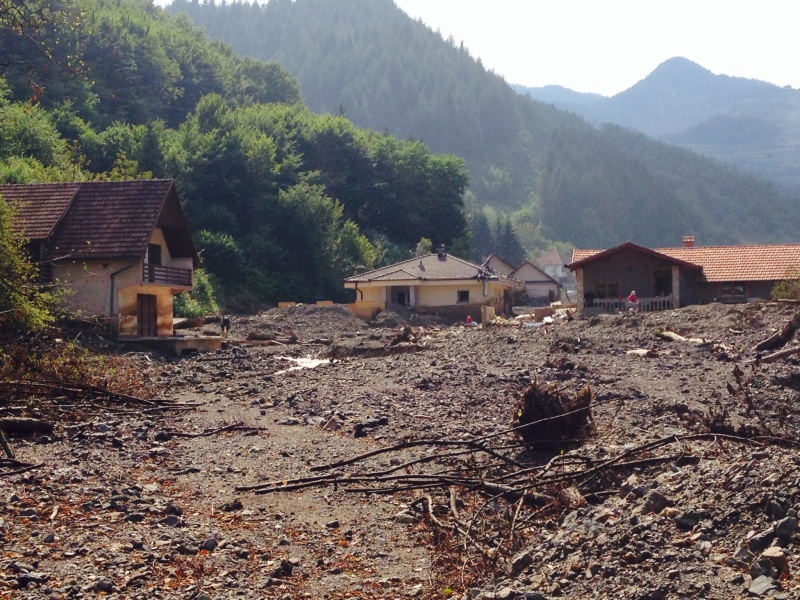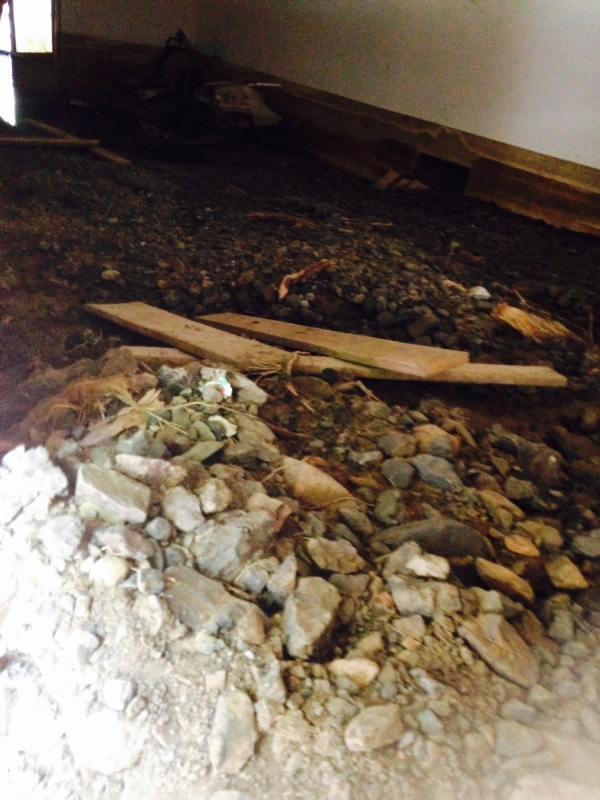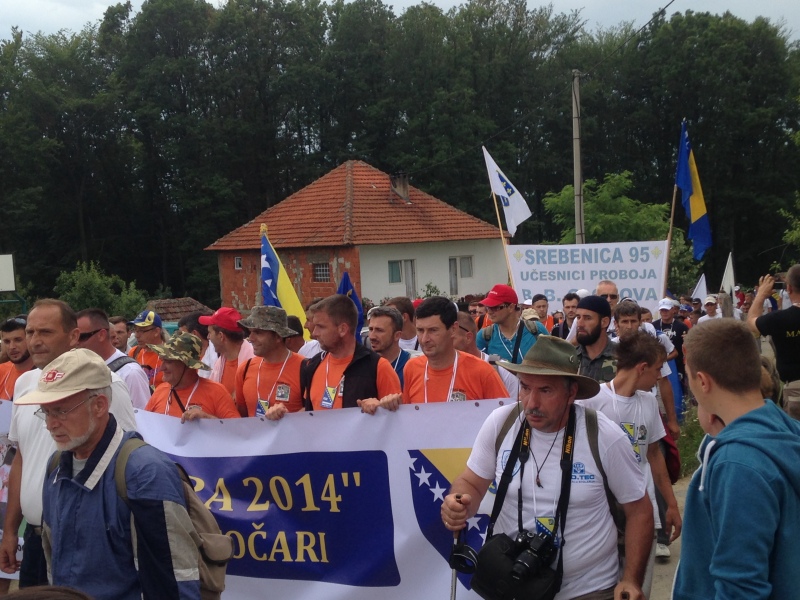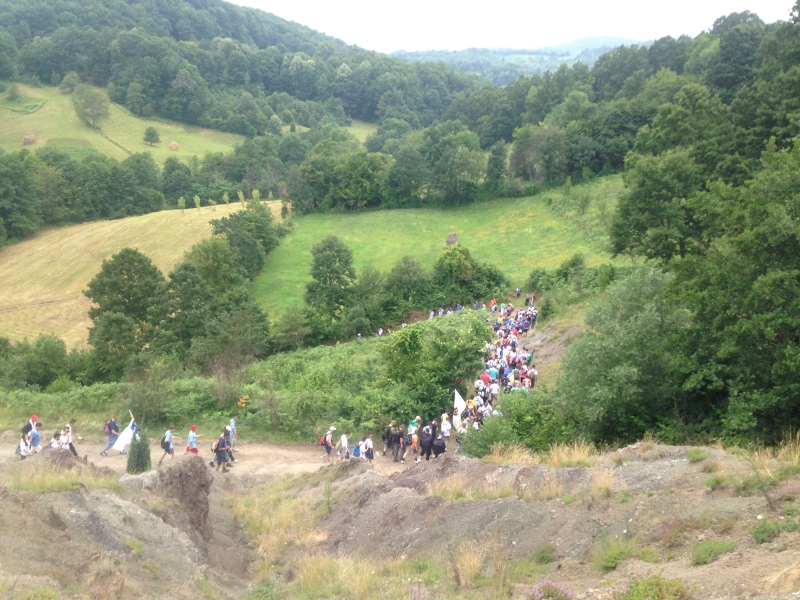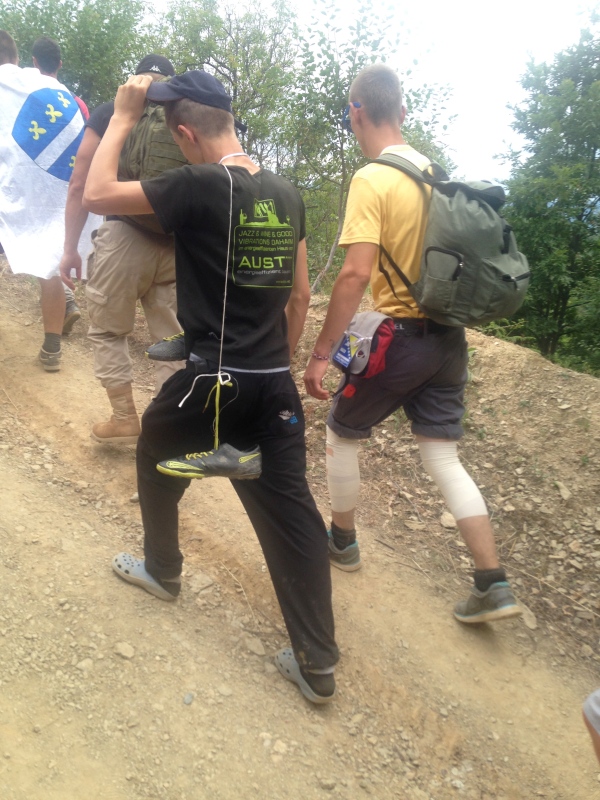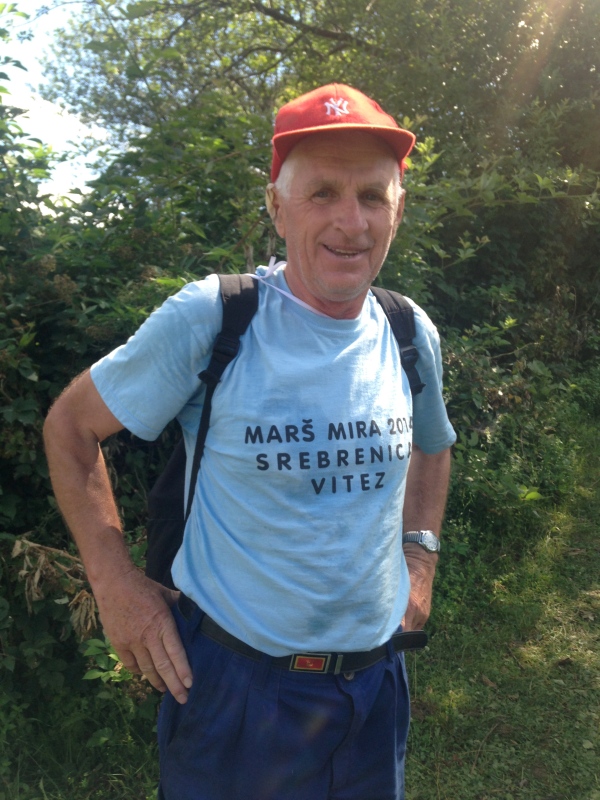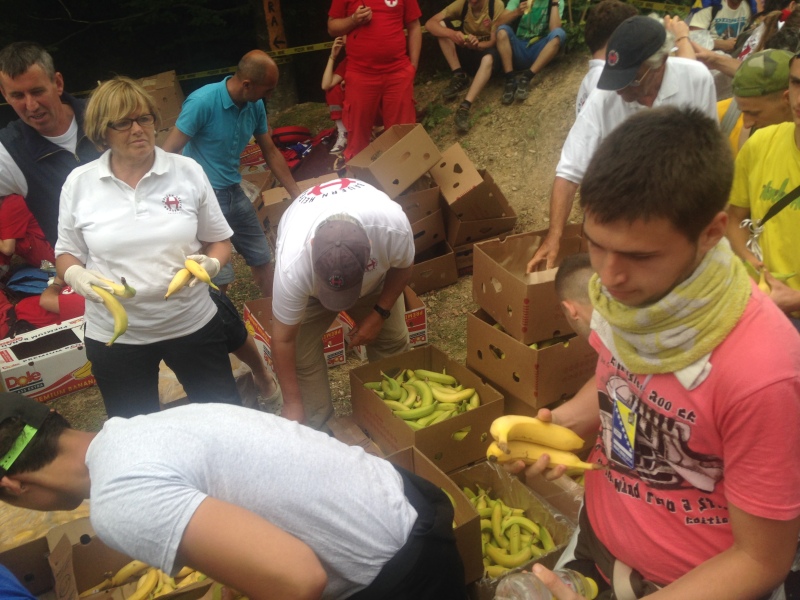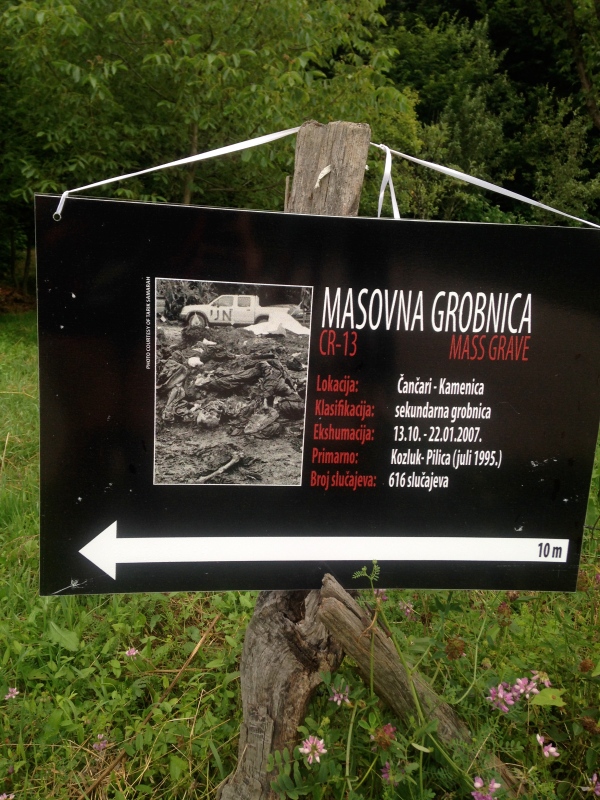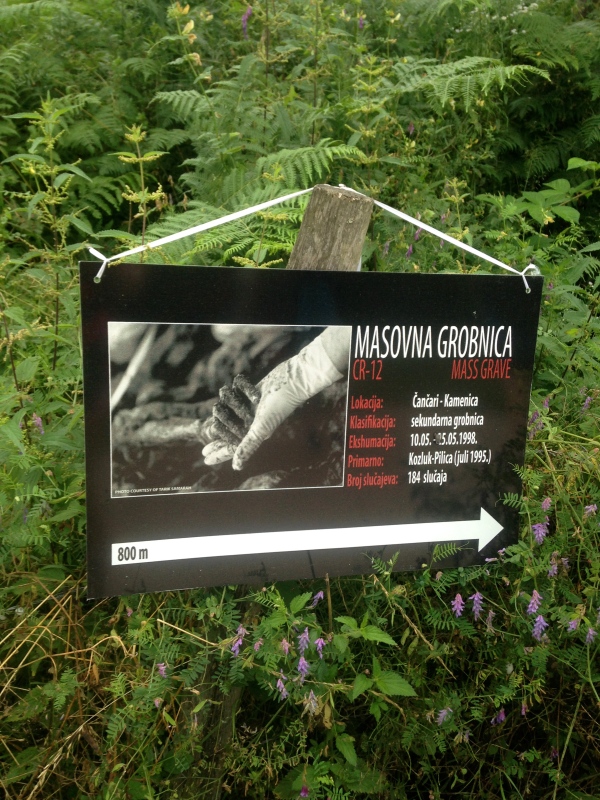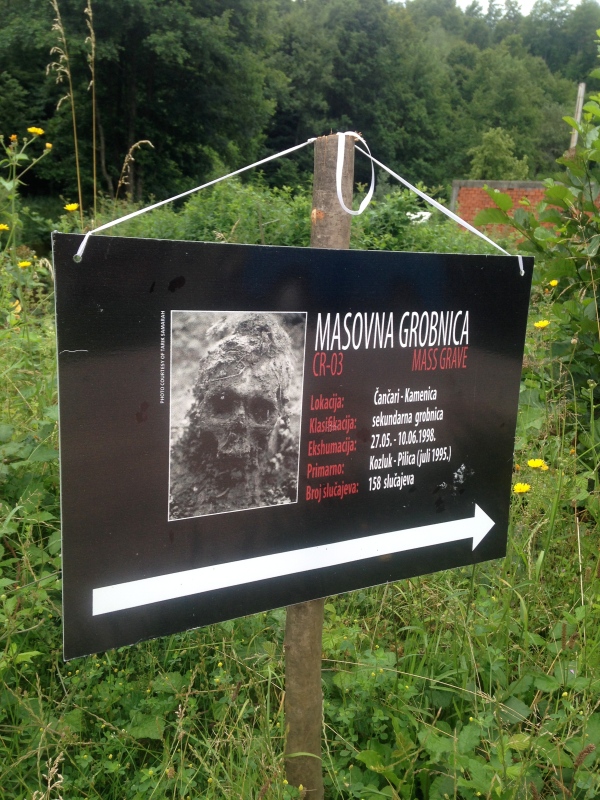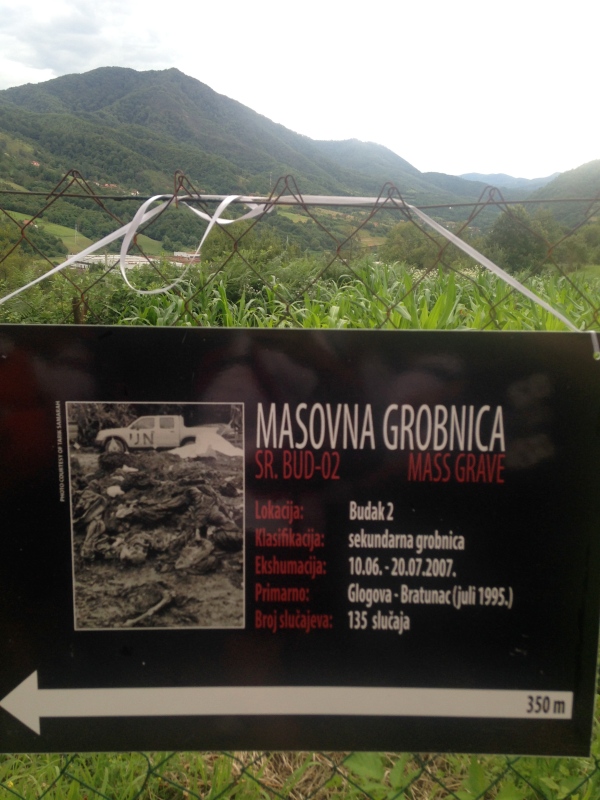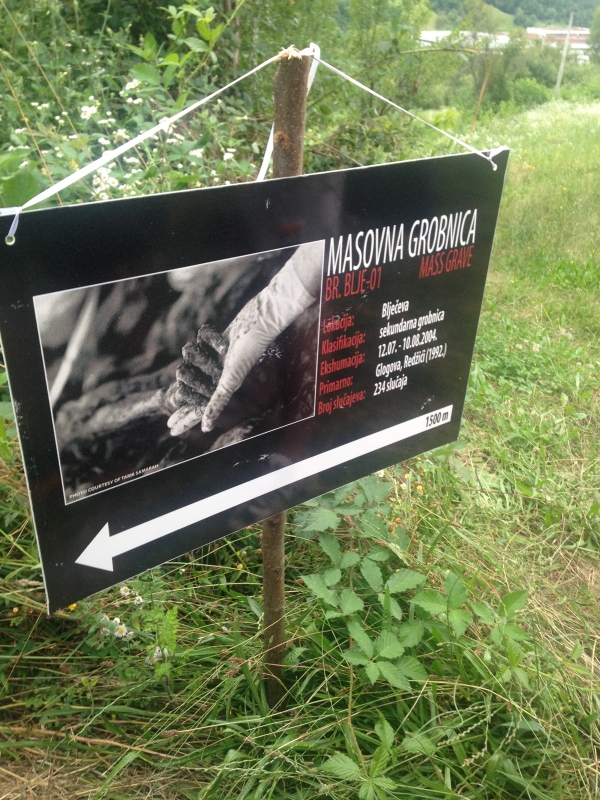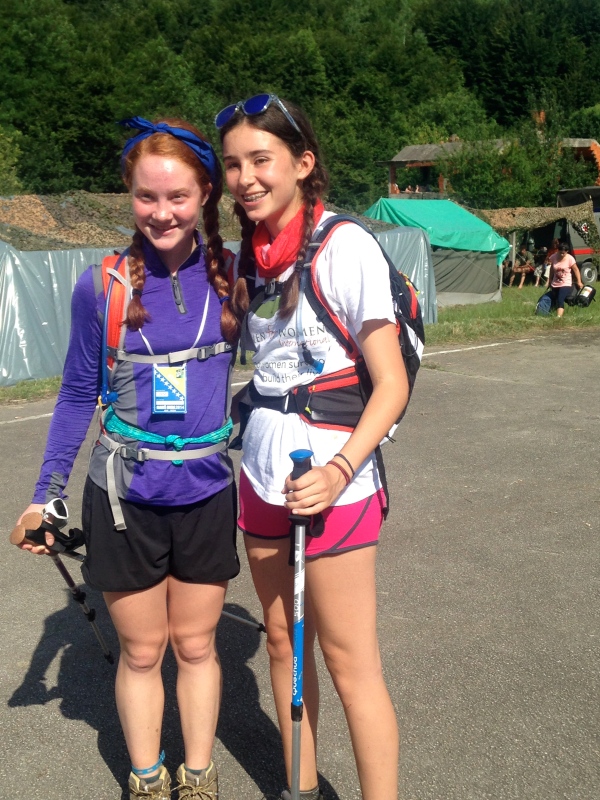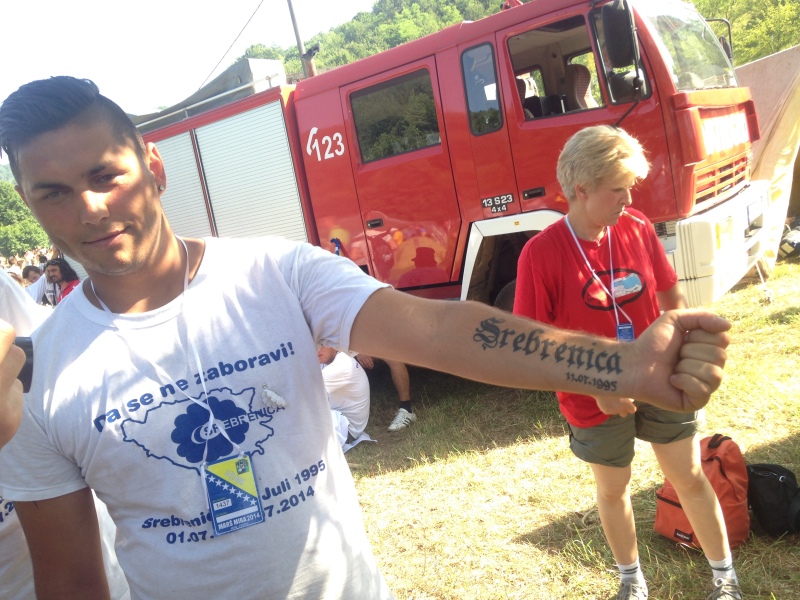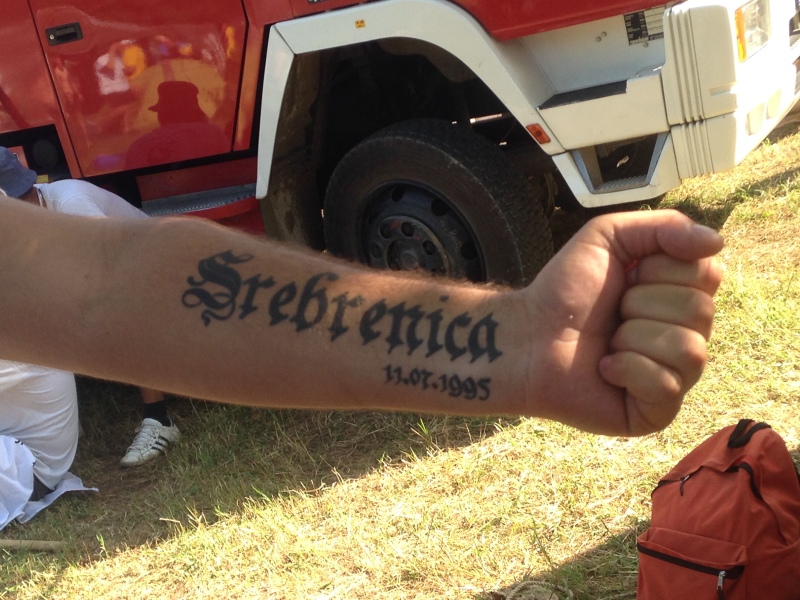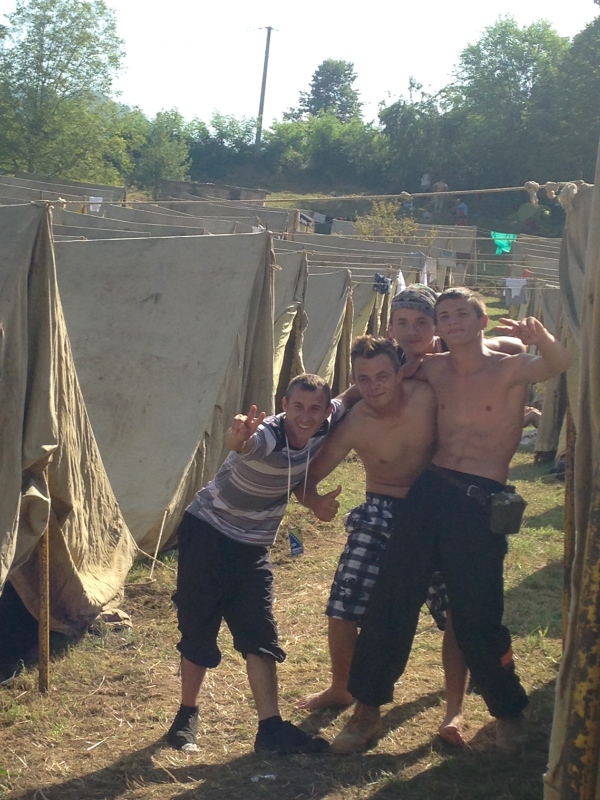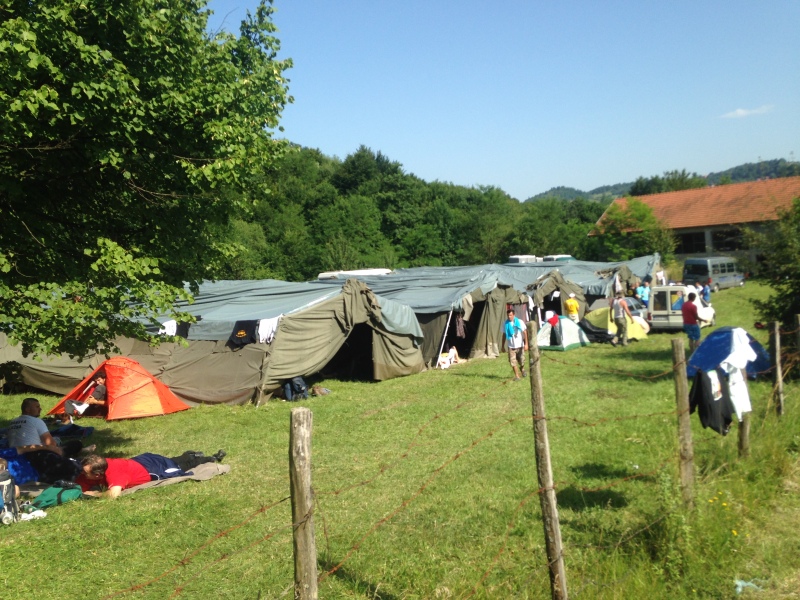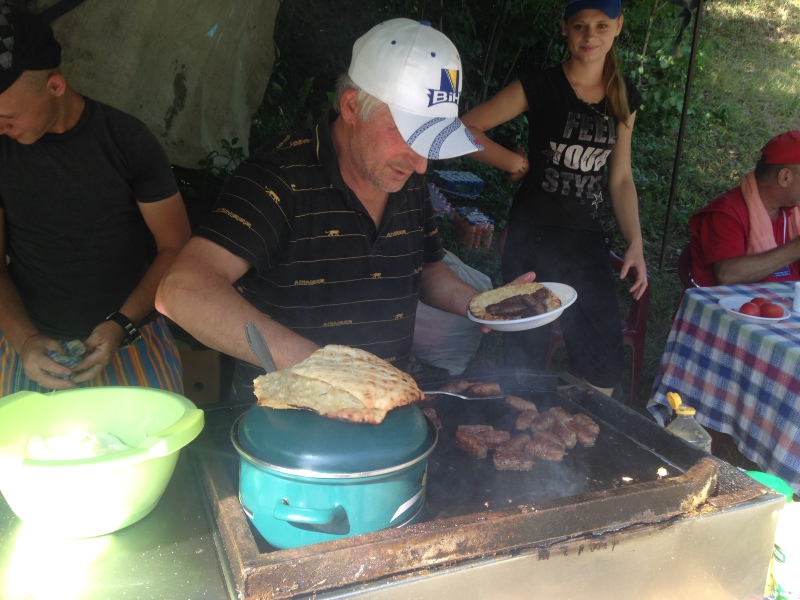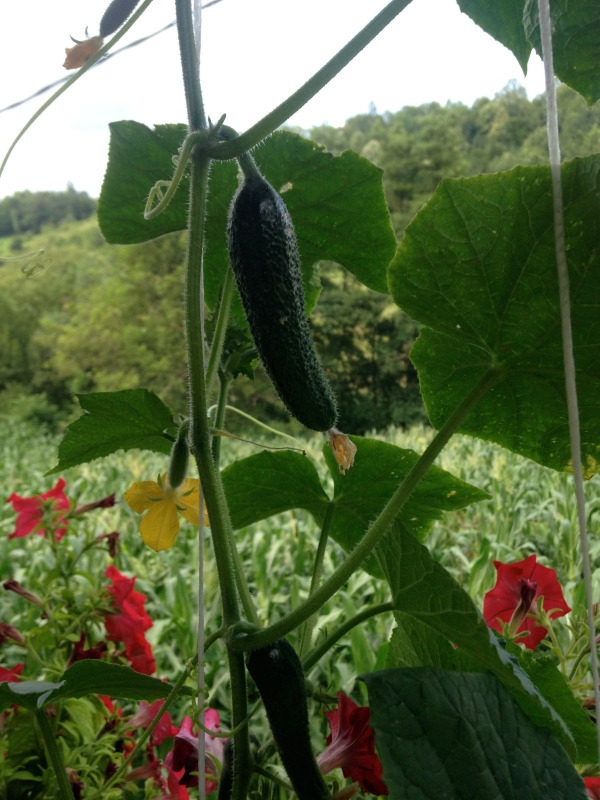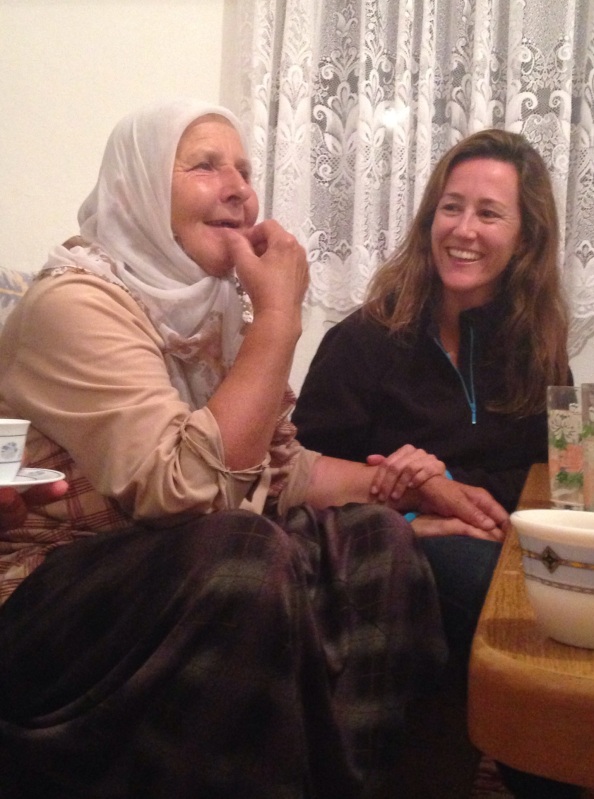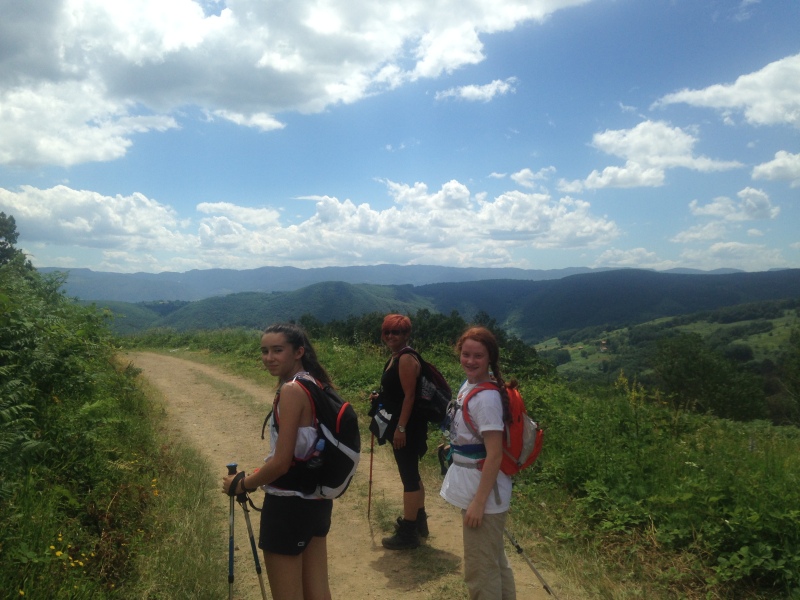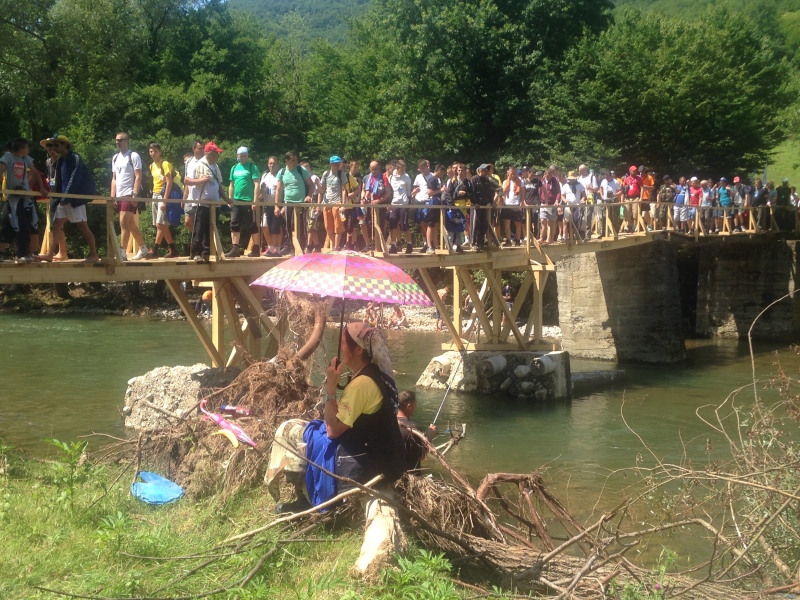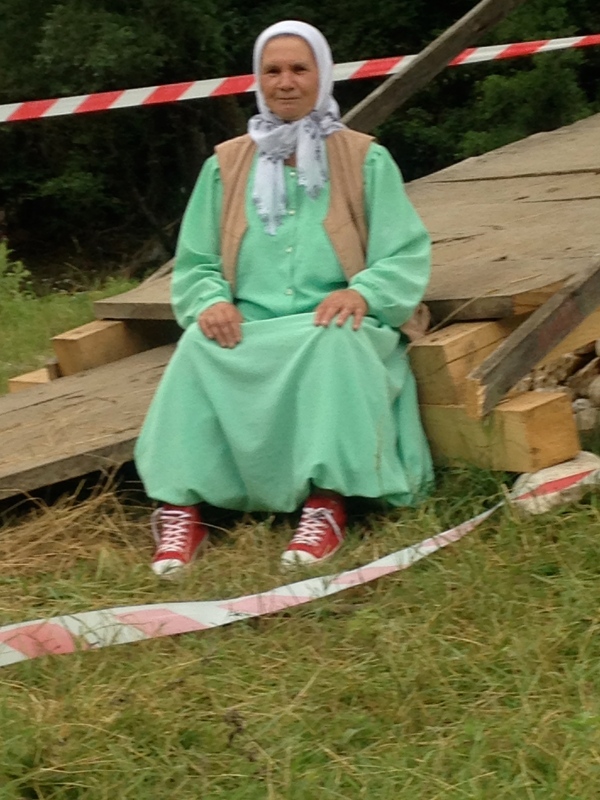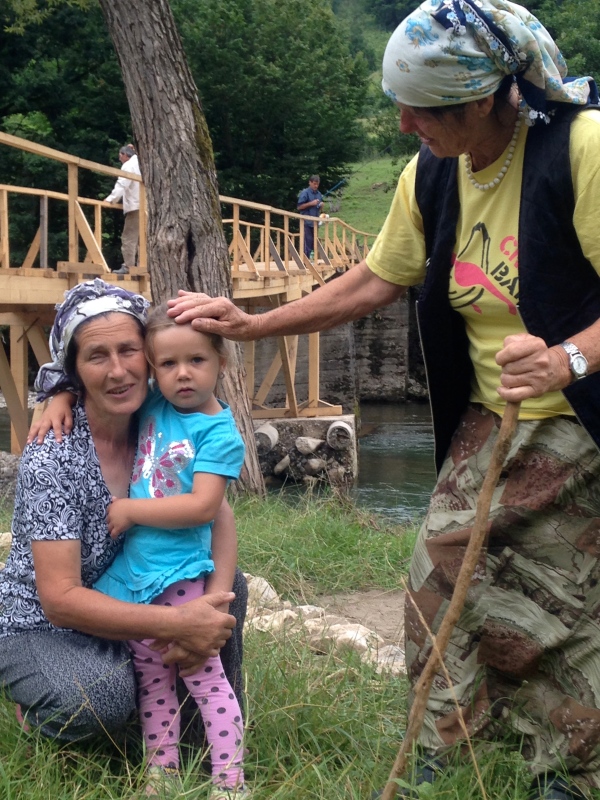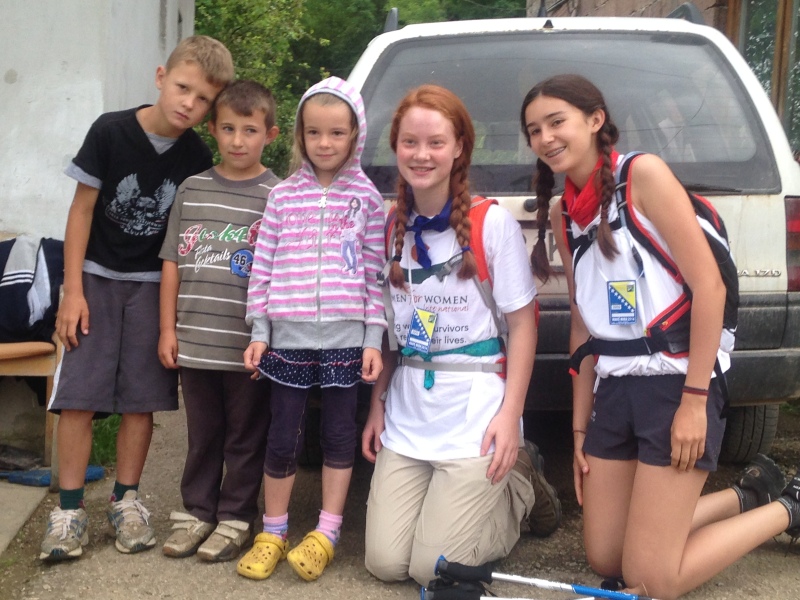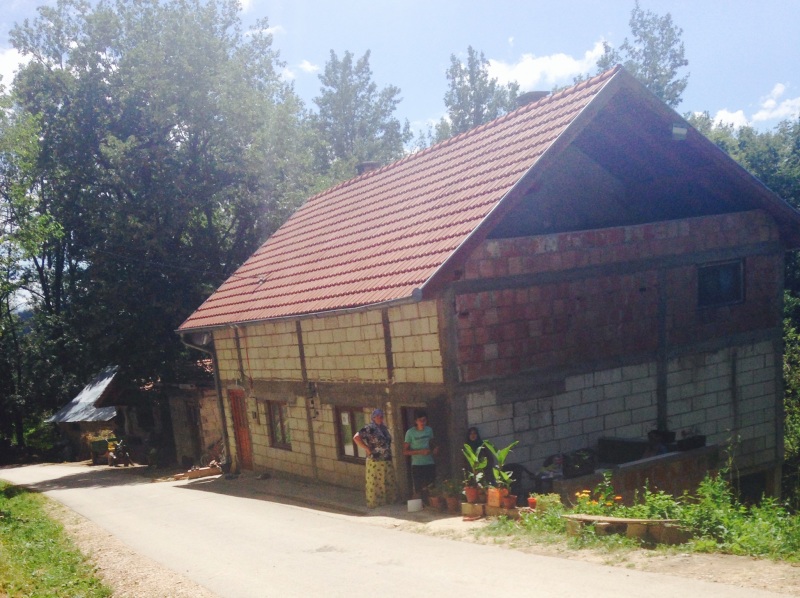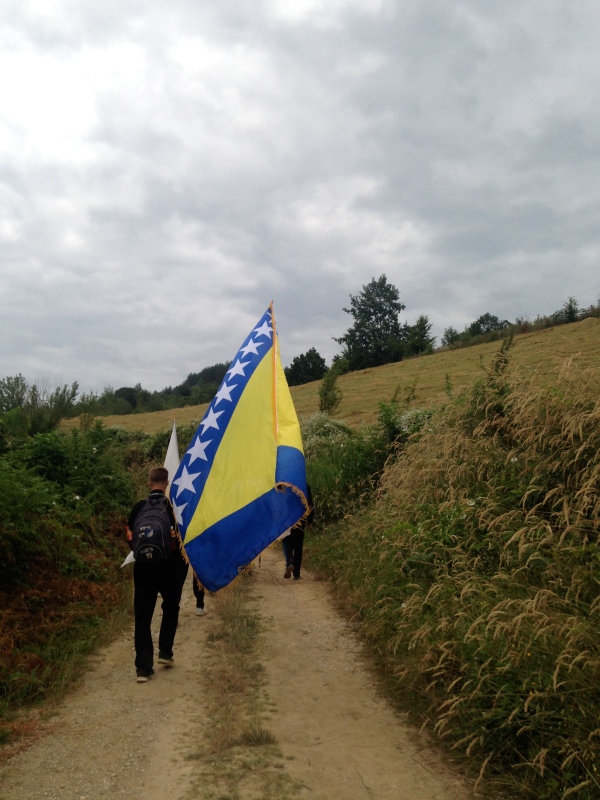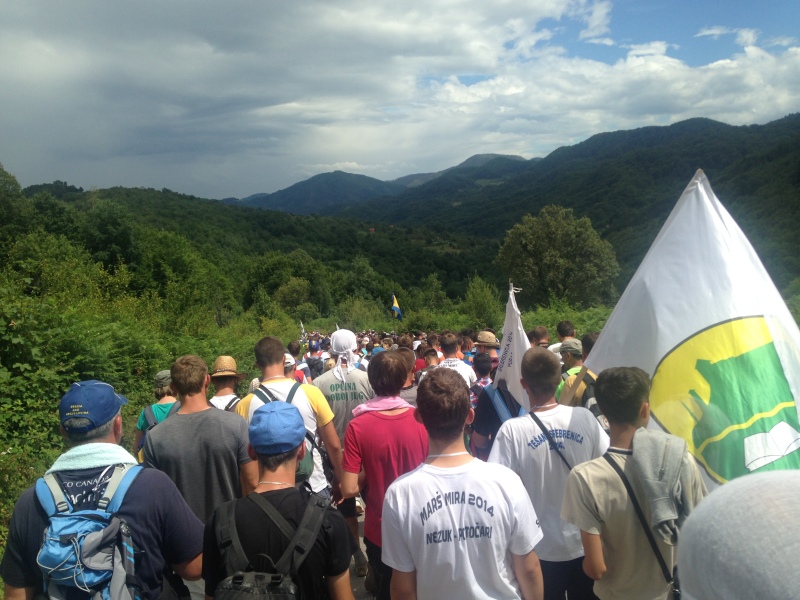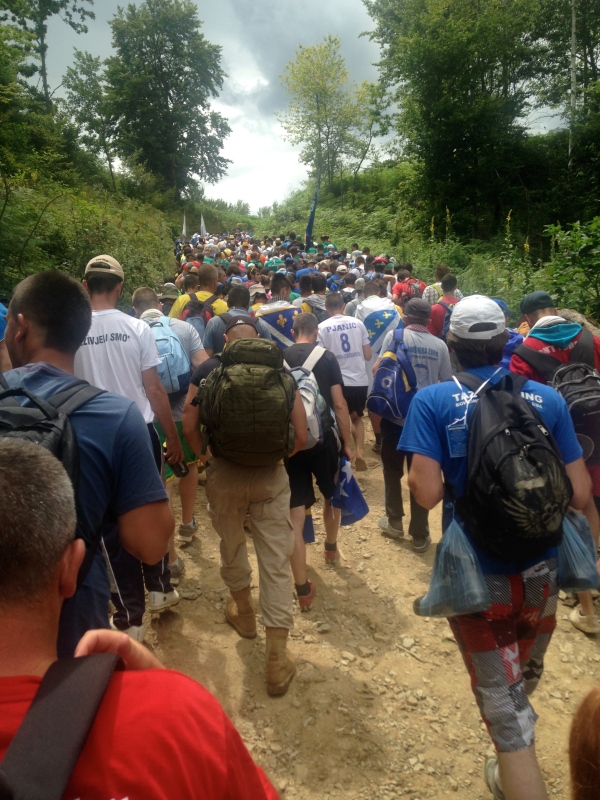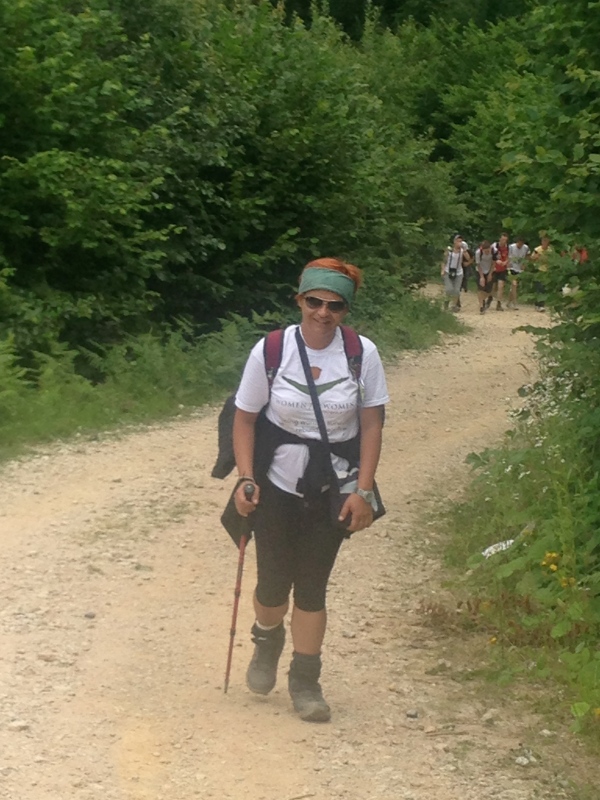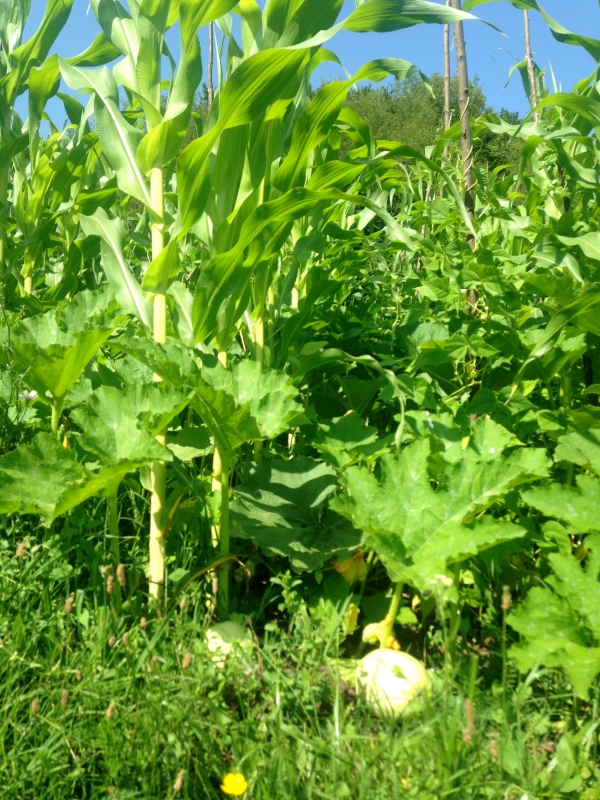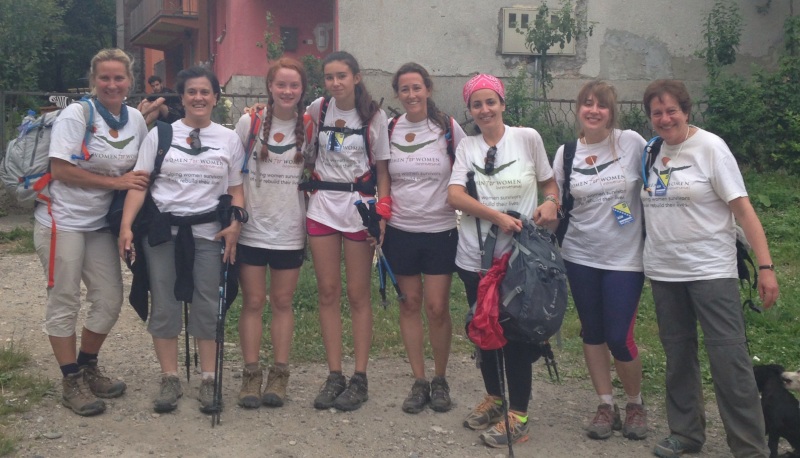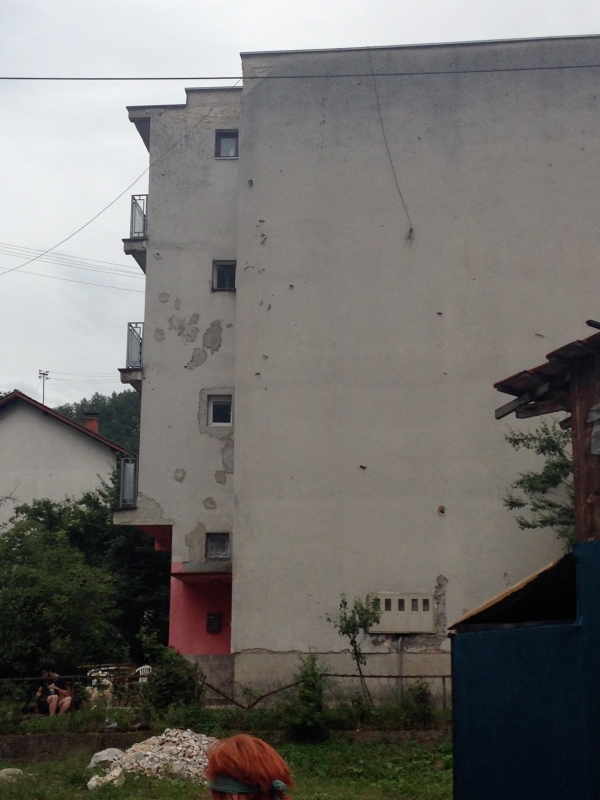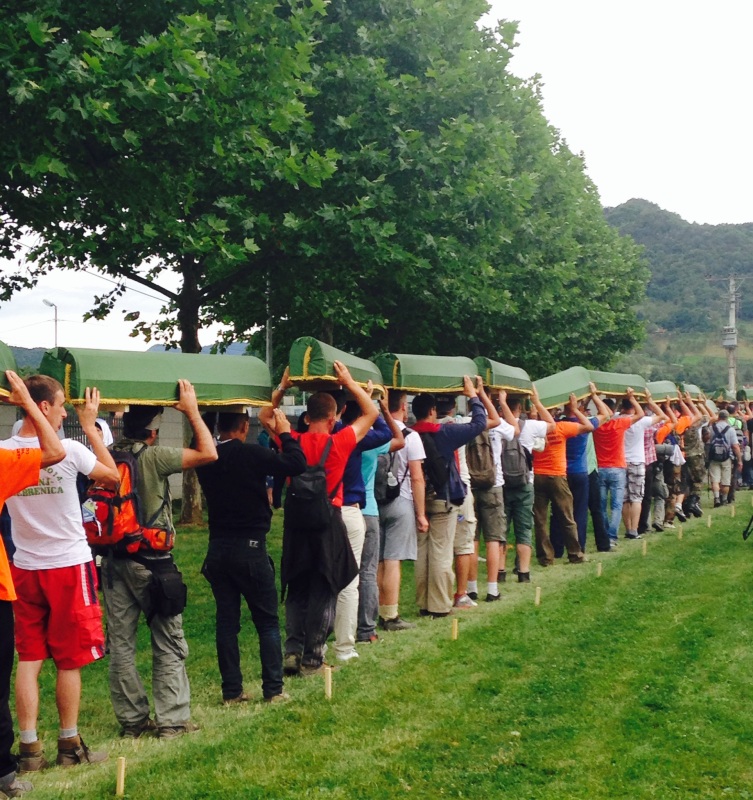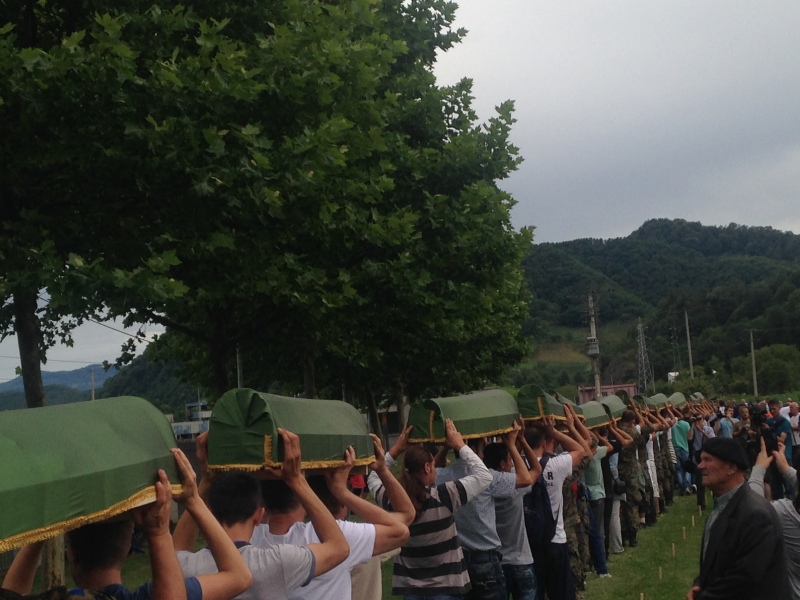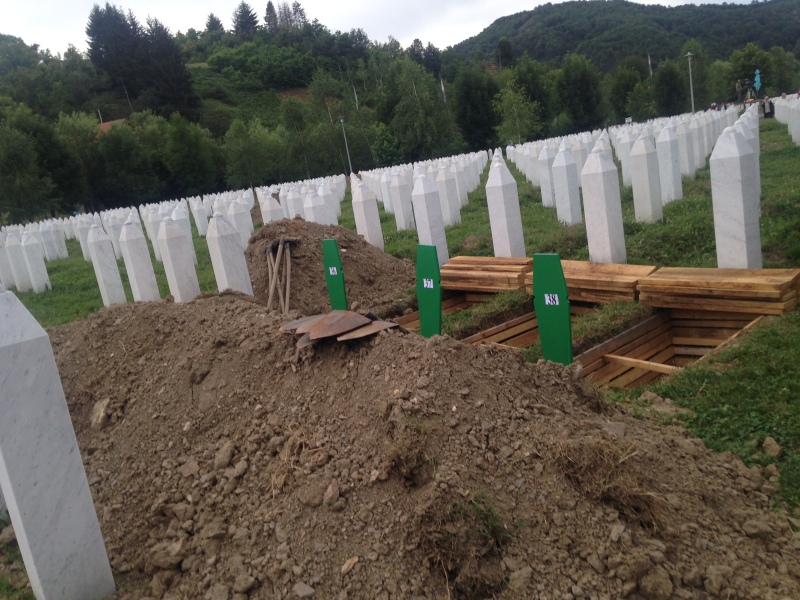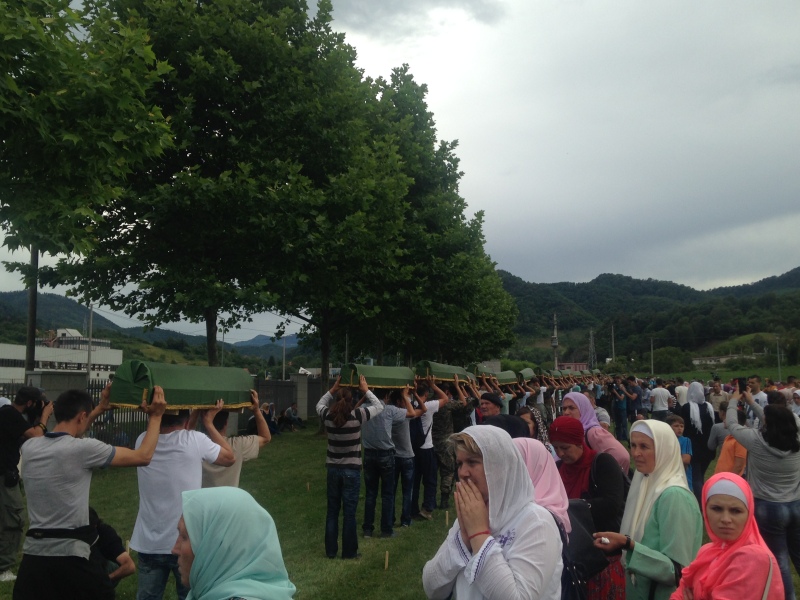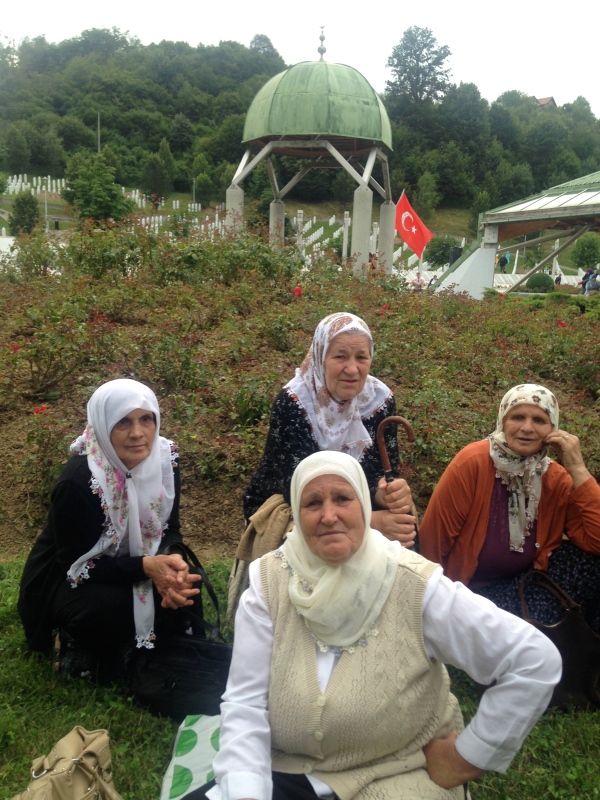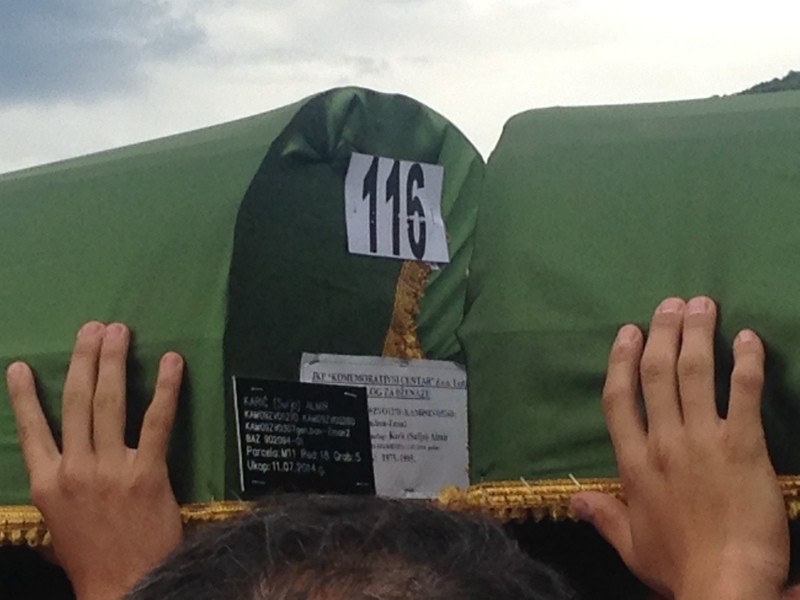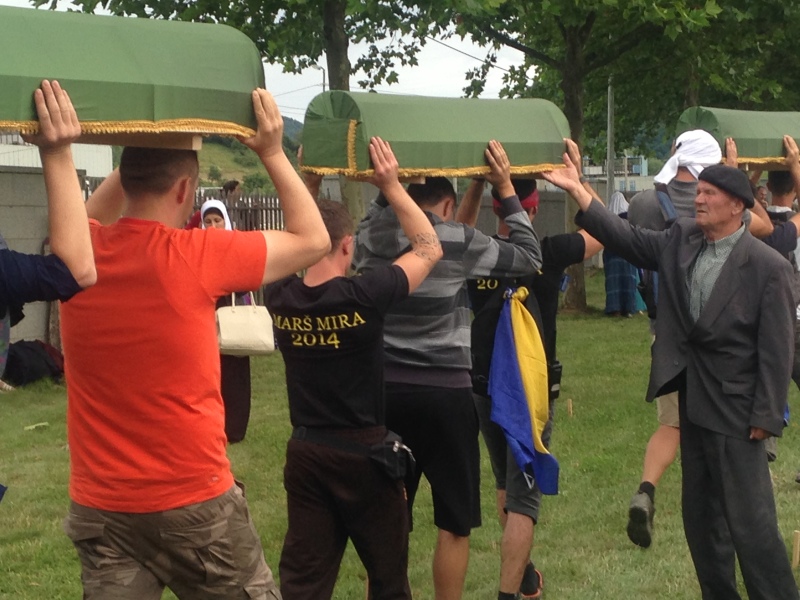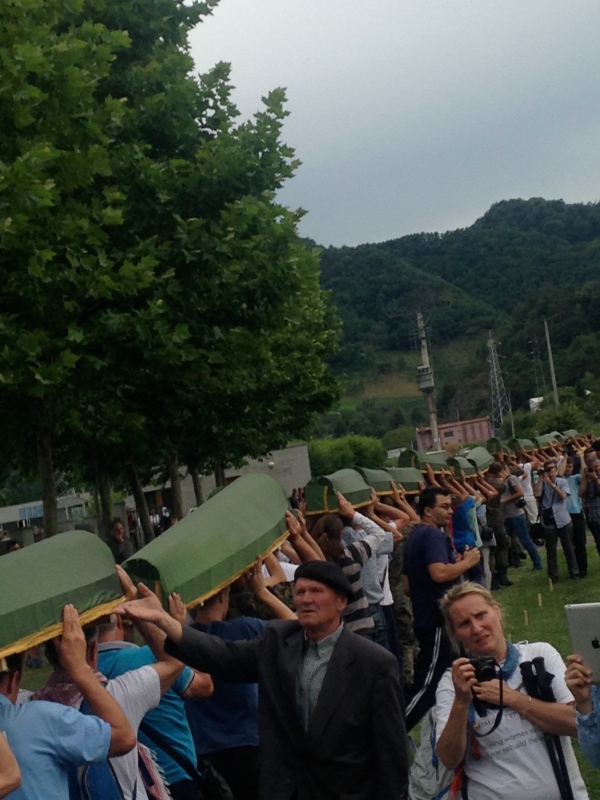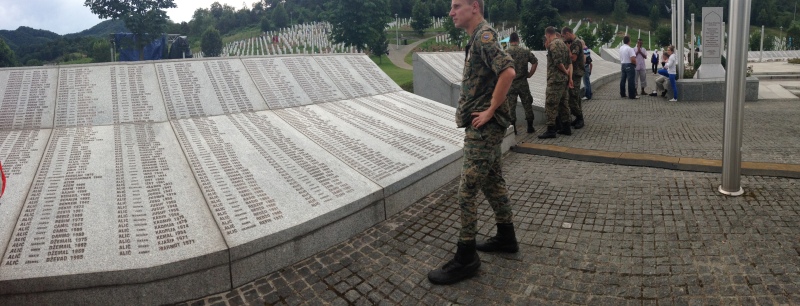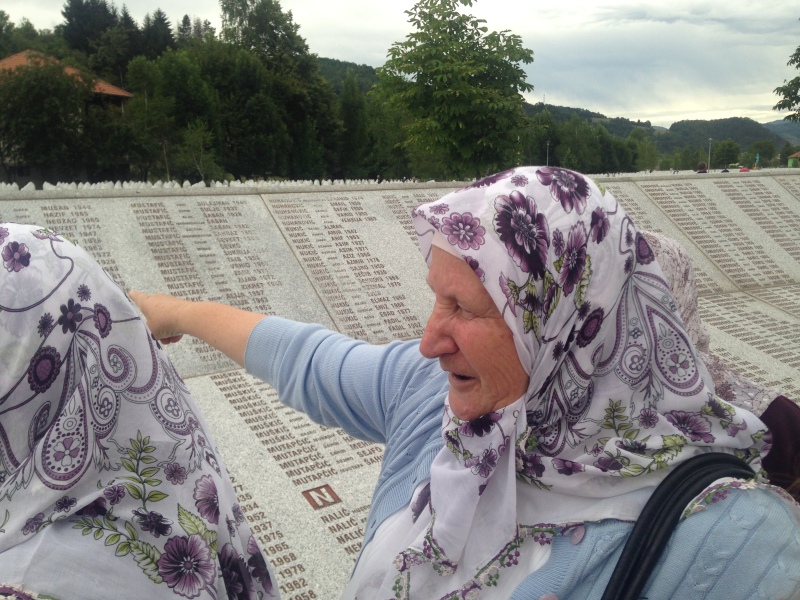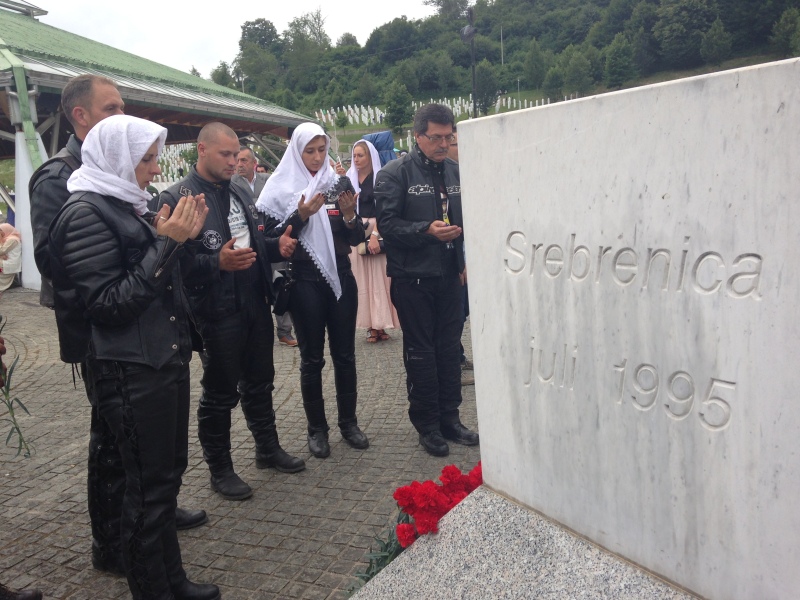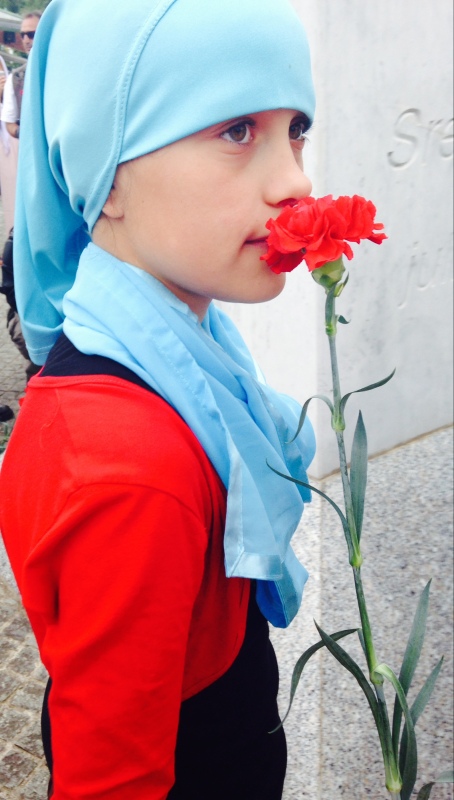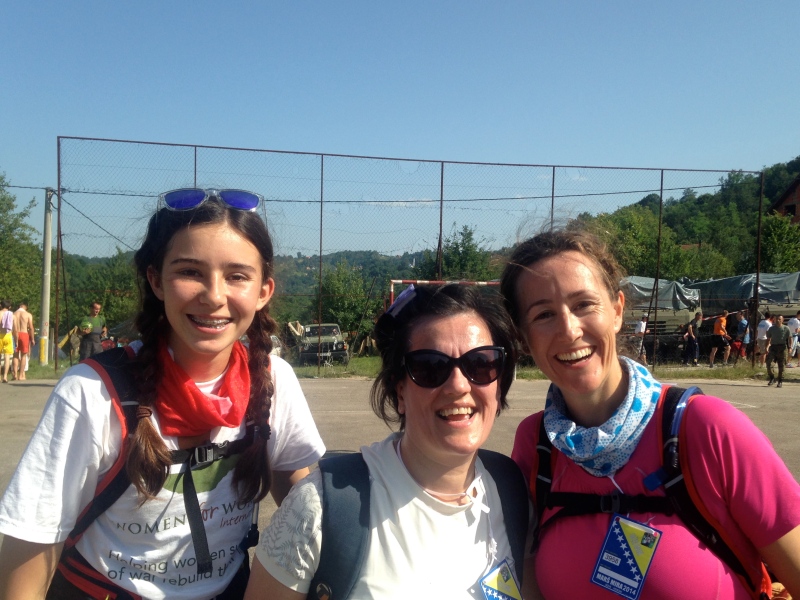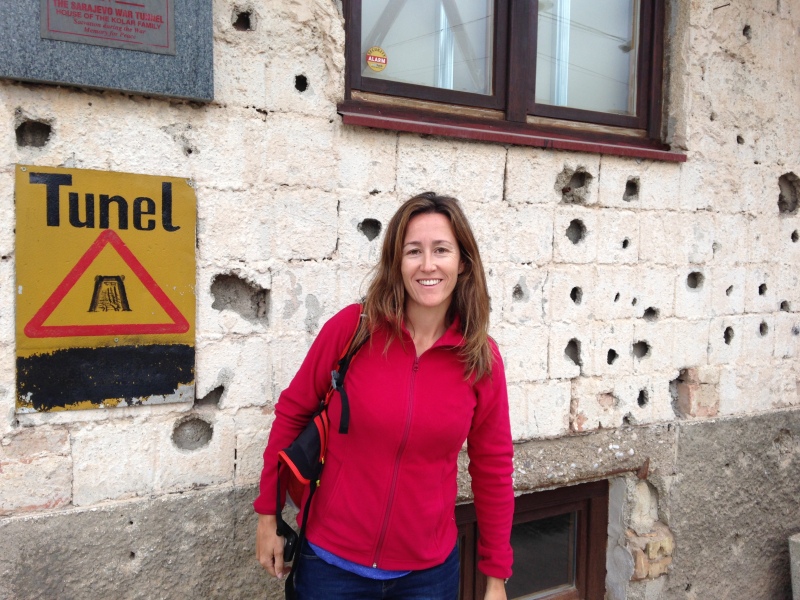We have written our report of our experience in Bosnia & Herzegovina as our homage to our dear friends Elvir, Noura and Refija and in memory of all the innocent victims of the war.
You are always in our hearts
WE WILL NEVER FORGET SREBRENICA
Dearest friends,
We’d like to start saying that no matter what words Maria and I use to describe our experience in Bosnia & Herzegovina, we will not be able to truly convey how we felt and the love we received from the people we met.
In any case, we will endeavor to share with you the best we can our days during the March of Peace and would like to thank all of you who have faith in Women for Women International (WfWI) and have contributed to support their projects economically. We have managed to raise £3,021 which is wonderful and will help more women rebuild their lives after the war.
Apologies for making this soooooo long but we don’t want to leave anything out. If you don’t have enough time to read it all, we suggest you go straight to Elvir’s story, Visit to Noura and Refija at their home and The end of the March arriving at the Memorial. Also at the end you will find a section with Historical Background we managed to gather from all our conversations during the trip.
Before we start…
Historically, Bosnia & Herzegovina’s population has been formed by different ethnic groups:
- Bosnian Muslims (known as Bosniaks, descendants of the Turks when the Ottoman Empire invaded the area in 1500s)
- Bosnian Catholic Croats (Roman Catholics who have close cultural ties with neighbouring Croatia)
- Bosnian Orthodox Serbs (who have close cultural ties with neighbouring Serbia)
- Minority Jew and Hungarian communities
They all shared linguistic and cultural histories and traits, ensuring they co-existed side by side in relative peace. Marriages crossing the “ethnic line” were common and most people defined themselves as Bosnian first before declaring any ethnic group partisanship.
The War in Bosnia & Herzegovina, commonly known as the Bosnian War, was an international armed conflict that took place between March 1992 and November 1995. The conflict came about as a result of the breakup of Yugoslavia which comprised what today we know as Bosnia & Herzegovina, Croatia, Macedonia, Montenegro, Serbia and Slovenia.
Following the collapse of communism, nationalists won the first multi-party elections and formed a coalition government despite having conflicting goals:
- Muslim nationalists wanted a centralised independent Bosnia
- Croats wanted to join independent Croatian state
- Serb nationalists wanted to stay in Serb-dominated Yugoslavia
Bosnia & Herzegovina held a referendum on independence in February 1992, which was boycotted by the Bosnia Serbs. After the independence was declared (and recognised by the EU), Serb and federal Yugoslav armies entered Bosnia to secure Serb areas. War broke out and Serbs, under the leadership of Radovan Karadzic, lay siege to capital city Sarajevo. They occupied 70% of the country killing and persecuting Muslims and Croats to carve our a Serb Republic.
The war lasted 44 months causing the death of 100,000 people and the displacement of 2 million men, women and children.
Our trip to Bosnia and Herzegovina
Maria and I flew out on Monday 7th July on an early flight to Munich and continued straight on to Sarajevo. We were both very excited about our trip but quite unsure of what we would encounter.
Just landing at Sarajevo and walking towards passport control was already very contrasting as the airport felt so peaceful surrounded by beautiful green mountains but at the same time I couldn’t avoid remembering that during the Sarajevo siege the Serbs were hiding in the mountains leaving the Bosniaks in Sarajevo very unprotected and easy to target. We realized then that the ghost of the war would follow us endlessly during our days in Bosnia-Herzegovina. Everywhere we looked or anyone we talked to would remind us of the war.

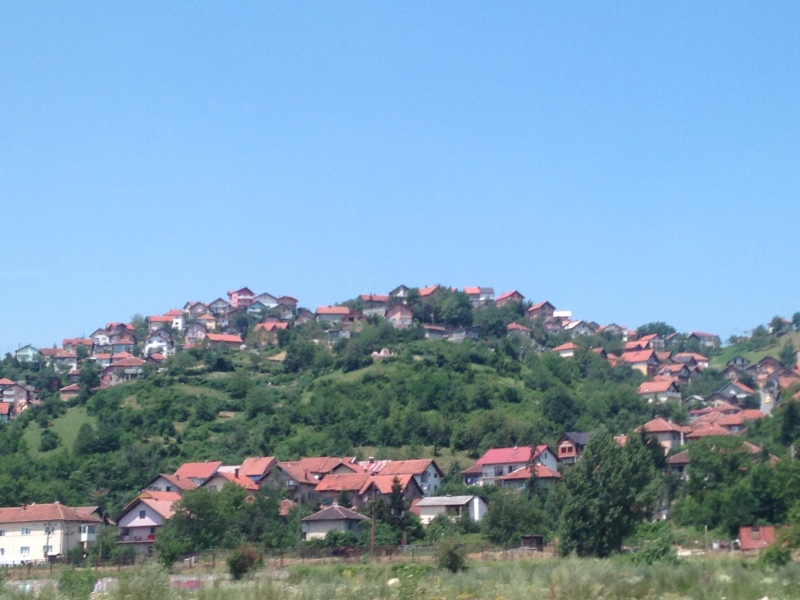
 We soon arrived at WfWI’s office in Sarajevo where we first met Seida Saric, the Country Director -always so full of life and energy! She showed us a collection of woolen clothes knitted by women who take part in the program and we saw this wonderful book If you knew me you would care by Zainab Salbi (founder of WfWI) which collects the stories of women who have survived wars, violence, and poverty. The stories go beyond tears and victimhood and reveal joy, love, and forgiveness.
We soon arrived at WfWI’s office in Sarajevo where we first met Seida Saric, the Country Director -always so full of life and energy! She showed us a collection of woolen clothes knitted by women who take part in the program and we saw this wonderful book If you knew me you would care by Zainab Salbi (founder of WfWI) which collects the stories of women who have survived wars, violence, and poverty. The stories go beyond tears and victimhood and reveal joy, love, and forgiveness.
We soon took off to meet the rest of the group with whom we would be spending the next days doing the march: Amra Krvavac and Alen Mujčinović (who both work at WFWI Bosnia Herzegovina), Danielle Mason (who works for WFWI UK) and her mother Lee-Anne Mason, Maura Roy (from London) and Tracy Craighead and her daughter Cecily (from NY). Coincidentally 3 pairs of mothers and daughters!
As we drove from Sarajevo to Tuzla, the starting point of the March of Peace, we stopped to visit a medicinal herb farm run by WfWI – 10.000 squared meters distributed around the village where the women mainly plant Melissa (lemon balm) and Calendula. We learned that Melissa is planted every eight years but Calendula doesn’t resist the winter low temperatures so it needs to be replanted every year. The flower from the Calendula needs to be picked every 3 or 4 days so they often need help from their families to complete the job. The collection is very abundant and cutting blooms encourages more budding so they would greatly benefit from a dryer machine that would allow them to escalate the business.


 As we continued our drive towards Tuzla, we stopped at a village that had been completely buried in mud due to recent heavy rains and landslides. We met the lady in the photo (with a green t-shirt) who coincidentally was a graduate of one of Women for Women’s programs in Bosnia.
As we continued our drive towards Tuzla, we stopped at a village that had been completely buried in mud due to recent heavy rains and landslides. We met the lady in the photo (with a green t-shirt) who coincidentally was a graduate of one of Women for Women’s programs in Bosnia.
 She showed us pictures of the village before the landslide and to our surprise realised that the houses in the pictures actually have 2 floors but the ground floor has disappeared below the mud!
She showed us pictures of the village before the landslide and to our surprise realised that the houses in the pictures actually have 2 floors but the ground floor has disappeared below the mud!


 Below are some pictures of her house. She had managed to clean up a lot of it but still had a lot of work to do. She didn’t want to leave her home as she said she had already been an evacuee during the war and wasn’t ready to go through it again.
Below are some pictures of her house. She had managed to clean up a lot of it but still had a lot of work to do. She didn’t want to leave her home as she said she had already been an evacuee during the war and wasn’t ready to go through it again.
All the mud was being removed by hand. Unfortunately they didn’t receive any help from the Government – it would have been so much easier if they had an excavator!
She showed us a big barn (see pictures below) which was almost ready to start a chicken farm with capacity for 200 chicken. Sadly everything had been destroyed and was buried in mud.
 This woman really impressed us – she is a remarkable woman with a huge stamina who despite the devastating surroundings, kept her smile and strength to continue. Admirable.
This woman really impressed us – she is a remarkable woman with a huge stamina who despite the devastating surroundings, kept her smile and strength to continue. Admirable.
After this stop we resumed our route towards Nezuk where we would start the march on the following day.
March of Peace (8th July to 10th July 2014)
This year’s March of Peace (‘Mars Mira’ in Bosnian) would mark the 19th anniversary of the genocide in Srebrenica. The 110km route is the same as the one taken in July 1995 by thousands of fleeing Bosnian Muslims after the UN-designated ‘safe area’ of Srebrenica was taken over by Serbian forces. In an attempt to escape certain death, they fled through woods and across hills to try to reach free territory. Many died on route but those who survived arrived six days later at the village of Nezuk, the first settlement under control of the Bosnian Army. The Peace March is walked in the opposite direction as a symbolic return to Srebrenica.
What happened in Srebrenica in July 1995 has been described as the worst crime on European soil since World War II. UN forces failed to provide protection to the town’s Muslim population and more than 8,000 were massacred by units of the Army of Republika Srpska under the command of General Ratko Mladić.
The aim of the March is to commemorate all those who lost their lives in this atrocity and to ensure it is never forgotten or repeated. The identification of victims’ remains from mass graves continues to this day and following the March there is a huge memorial service in Srebrenica where those named in the past year can be laid to rest.
In the map below you can see the route we walked during the next three days remembering those who fled Srebrenica towards safe territory. We would walk the inverse route starting in the village of Nezuk (safe territory during the war, although today its part of Republika Srpska) and after 3 days and 110km we would reach Potocari (5km away from Srebrenica) former site of the UN base and now a Memorial to the genocide.
The route of the March falls in the territory of the semi-autonomous Republika Srpska, the region of Bosnia-Herzegovina given to the control of the Bosnian Serbs as part of the Dayton peace agreement.
- According to UN resolutions, Srebrenica was declared as ‘protected territory’ and became a demilitarised zone on 16th April 1993.
- On 11th July 1995, around 4pm, Srebrenica fell under Serbian control.
- On 11th of July in a place called Šušnjari, a column formed by 10.000 to 15.000 people, 15km long, followed the path to freedom. The path was long, around 100 km. A third of these people were members of the 28th division of ARBiH (army of Bosnia and Herzegovina), and the rest were civilians. They had almost no ammunition, no clothes and no food.
- On 12th July, after the attack on the column in the area of Kameničko brdo, the column was split into two. Only one half would arrive to a free territory of Nezuk on 16th July 1995.
- On 13th July, at the junction of Konjević Polje – Nova Kasaba and river Jadar, the column was attacked by occupators.
- On 14th July the column was ambushed near a place called Snagovo.
- During the night of 14th July, the column passed the junction Zvornik-Tuzla, in the region of Crni Vrh, and then continued to Križevačke njive – Baljkovići
- On 16th July 1995, after a breach on Baljkovići, a column of 3.500 men and women successfully migrated from Srebrenica to free territory in a village called Nezuk.
- Number of killed people which is not final: 8.372…
- From July 1995, genocide and mass plan murdering occurred in Srebrenica followed by the extermination of Bosnian men and children. Genocide was planned and executed by General Ratko Mladić and the army of Republic Srpska with help of other special military forces (known as ‘Scoprpions’) controlled by the Ministry of Internal Affairs of Serbia.
On Tuesday 8th July we started walking the March of Peace.
 We were very impressed by the breathtaking landscape. I never had expected it to be so green and leafy. Everywhere we looked was simply beautiful!
We were very impressed by the breathtaking landscape. I never had expected it to be so green and leafy. Everywhere we looked was simply beautiful!
We will continue to talk about the march later but first we would like to tell you Elvir’s story.
We met Elvir on Tuesday, the first night of the March. He came to visit us to the house where we were staying (beautiful garden, you will see it in pictures later on). As we all sat happily on a rug in the garden, after our wonderful hot shower, and feeling all relaxed, I don’t think any of us could have imagined what we were about to hear.
We’ve tried to put together what Elvir told us that night: In 1993 Srebrenica was declared United Nations safe territory. This attracted lots of people from the other parts of the country. In normal circumstances, Srebrenica would have around 4,000 inhabitants but since it became UN safe territory it had a population of around 50,000 people. The UN demilitarised the people living there (Bosniaks) but didn’t demilitirise the Serbs as there were no Serbs living in Srebrenica.
In July 1995, Bosnian Serb troops led by Ratko Mladić arrived at the town of Srebrenica and began bombing it. The Dutch Commander in charge of the UN base at Srebrenica met with Mladić to try to negotiate the release of thousands of refugees that were gathering at the UN Dutch base in Potocari and to ask him not to hurt the Dutch peacemakers.
Buses arrived in Srebrenica to transport women and children to safe territory controlled by the Bosnian Army. During the deportations, Serb forces began selecting all men aged over 12 for ‘interrogation of suspected war crimes’. These boys and men were then held in lorries and warehouses.
Elvir’s father and his brother were at the front of the column with the Bosnian army and with a commander who we actually met in during the March, one of the few survivors. When the Serbs realised what was happening, the column broke. Some people who were at the front of the column managed to survive and reach Nezuk, others died.
Once the column split, a lot of people didn’t know where to go, they were disorientated, so they started going on different ways. There was a lot of panic and chaos. Some people went to the mountains where they got chased and shot at. Another group was surrounded and killed. Some people surrendered and got killed. Some people ended up in a field but Serbian soldiers were waiting for them with tanks, artillery and killed a big group of 1,500 people at one go.
Elvir escaped into the mountains with a group of about 15 people. They hid in the bushes for days. After a few days, Elvir’s group was chased with dogs forcing them to run down the mountain to trap them between the dogs and where they had started the column. Elvir was lucky because one of the men in his group was a policeman and was used to working with those dogs so they managed to avoid them.
However hiding in the mountains was very hard. Even drinking water from the river became a problem because the Serbs had intoxicated the river with chemicals so when they went down to drink the poisoned water, they started to have hallucinations. People would go crazy and hallucinate with dogs chasing them or seeing the lights of the city. Elvir managed to hide in the trees and stay safe.
They stayed hidden in the forest although they had to go back to Srebrenica a few times in search of food because they were too hungry – but would quickly escape back to the mountains to hide.
One day they saw a man with no eyes running down the mountain. They didn’t know whether to help him or not. They waited and realised it was a trap. The Serbs has taken his eyes out to attract Bosniaks to help him.
He also told us a story about a man who had been seriously injured and was being eaten alive by worms. He begged some Serbs who passed by to kill him but the Serb soldiers didn’t bother and just passed by.
Some of the men who escaped with Elvir would follow the electricity cables from the mountains to avoid getting lost as they would help them orientate following the roads.
Eventually the group split up, 10 went one way and the other 5 the other way. Part of the group died with landmines. They tried to get passed the front line but there were bombs so they had to break the wires and split again the group.
Finally, after approximately 60 terrifying days, Elvir managed to survive the genocide and reach safe territory. A man who fled in the ‘column’ weighed 86kgs when he fled from Srebrenica and ended weighing 48 kgs two months later when he arrived at safe territory.
More about the March of Peace
We constantly had the feeling that each km we walked was not even worth half of what other people were walking as we wore our super trekking boots and camel rucksacks while many others walked in very basic shoes whilst carrying a rug to sleep on. We felt very spoilt.
Some people were just remarkable, like veterans with prosthetic legs.
We met this man in sandals who works doing fiber glass. He told us he had worked until midnight on Monday, picked up his friend after work and travelled to Nuzuk where they had arrived at 3am to the camp in order to start the March at 7am on Tuesday.
Age wasn’t an impediment to join the March!
The man in a blue polo in the picture below is a survivor of the killings of Srebrenica. He had managed to escape when the genocide took place and arrive to Nezuk, safe territory. This is a photo of him with his family. We learned that during the escape from Srebrenica he had lost his brothers and nephews, having to carry the corpse of his sixteen year old nephew. Today he owns a construction company with 12 employers who are all survivors of the genocide.
From time to time we would stop for water and a snack given out by lots of voluntaries.
During the march we walked past lots of landmines which were clearly marked. When war was over everyone collaborated, including the Serbs, to look for the mines, locate them and deactivate them. As you can gather from the pictures, there are still areas that have not been checked yet.
Also during the March we walked past many, many, far too many mass graves. We marched through sites where captured Bosniaks were executed and mass graves have been discovered. We would all be quiet and stop for a moment of respect. This was probably so far the saddest part of the March (until we arrived at the memorial on Thursday).
Serbs know where each mass grave is but because they deny to the International Community that the genocide occurred, they have excavated many mass graves and moved the bones to a new area covering up their crimes so that the International Community cannot find them. This is making life very difficult for Bosniaks who are now finding bones belonging to the same person in two different mass graves (called primary and secondary mass graves).
This is the reason why many bodies have not been buried yet. Each year more bones are found and taken to the headquarters of the International Commission on Missing Persons outside of Sarajevo for DNA identification and matching with relative’s DNA. However, the remains of a body cannot be buried until a certain number of bones have been identified, so if it has been moved to a secondary mass grave, the victim’s family will not be able to bury the body until the remaining bones are found. Of course Serbs know where they are but will not collaborate (although some do so in exchange for money).
The bodies found and properly identified each year will be buried at the Memorial in Potocari during the ceremony which takes place the day after the March is completed (we’ll talk about this later).
There is still a lot of hatred and people cannot forgive as Serbs haven’t asked for forgiveness and victims live together with war criminals.
We don’t want to bore you with too many pictures we had to show these as each picture below shows a different mass grave. As I said earlier, far too many.
As we mentioned earlier, during the March we felt very spoilt as most people walking the March would sleep in tents and wash in the river whereas we would sleep at people’s homes who would kindly open their doors to a group of strangers. Here are some pictures of our arrival to the camp on our first day.
We would not sleep at the camp like the rest of the people who walked the march. Instead we would stay at nearby private homes where we could have a hot shower and sleep on a bed or sofa. Their hospitality was wonderful. Here are some pictures of the first house we stayed in and its beautiful garden:
Our visit to Noura and Refija
Both women have lost their three children and husbands. They live outside Srebrenica on a spectacular hill surrounded by mountains with an impressive 360º view of green mountains. This was certainly the most stunning view we had seen during our stay in Bosnia. They showed us their greenhouse and vegetable patch. It was so beautiful and looked absolutely professional! They grew green beans, courgettes, tomatoes as well as spinach and onions during winter. Outside in the vegetable patch they grew carrots, potatoes, pumpkin and fruit trees (although this year they hadn’t grown any fruits at all due to the landslides and flooding). They produce a lot but they just give it away to whoever comes by. They don’t sell anything as they do this as a hobby and they grow and take care of the plants as if they were their lost children. They have huge strong hands which prove they work very hard.
Inside their house they offered us elderberry juice, coffee, all sorts of chocolates and sweet treats, bananas, raspberries… We all sat around a table and enjoyed talking to them and their generous hospitality. The conversation flipped from laughter to crying, to laugher and crying again. We could feel how much they had suffered and how they still suffer everyday. Their lives are empty without their husbands and children. They try to fill their lives keeping themselves busy with the garden or knitting socks which they gave us as gifts. They told us they were once in Srebenica and bumped into French students who asked them if they sold knitted socks. They replied they didn’t but that they had a few at home and would be happy to give as a gift. When they got to their home they realised they had 50 pairs of socks which they gave to the French students. They promised they would sell them back home and bring the proceeds back – and eventually they did (around 300 pounds!).
They get along very well, like sisters, and joke a lot between them but then they would show us pictures of their sons and husbands and their smile would turn into tears. There was lots of crying as they talked about their families but they would immediately run to the kitchen to fetch more food or presents to distract themselves.
Noura’s husband and 3 children joined the ‘column’ to flee Srebrenica. Due to the chaos they lost one of her sons and the other two were badly injured with grenades. They were losing a lot of blood so they needed to drink water to rehydrate. Noura’s husband went to fetch water twice but never returned after the third time and she never heard of him again. Noura’s two sons couldn’t cope anymore with the pain and begged their mother to turn themselves in. They thought they would be sent to a hospital as they were still children and they didn’t expect Serbs to harm children. So they surrendered. Many people turned themselves in and were put into trucks. They were driven towards Tuzla, safe land. As they were approaching it the Serbs separated mothers from children. A soldier came, took the boys and pushed Noura away from them. She shouted ‘I don’t want to leave my boys’. But he assured her they would come after her. Noura had no option but to go. She thought they would be taken to a hospital. She didn’t want to be separated from her children but was told not to worry, they wouldn’t hurt children and they would be taken to hospital. But that was the last time she ever saw them. Noura buried her husband and one of her sons in 2008 and another son in 2011, she still hasn’t found the body of her middle son.
Refija had 3 sons – one of them drowned in the river when he was 16 years old, her husband died of a heart attack 3 months before the war started and her two other sons joined the ‘column’ with her. They soon got split from her as she was taken in a truck to safe territory towards Tuzla. Refija explained that as they were approaching safe territory, they had to step down of the truck and walk the last 6 km to Tuzla stepping over dead corpses and blood.
Her two sons tried to escape but their bodies were later found in a spot were many people had been executed. She buried them in 2010. Refija was tormented because one of her sons had left home with no shoes on and was hungry so she wondered if he had eaten before leaving home or had worn shoes, maybe things would have worked out differently.
Every Saturday Noura and Refija go to Srebrenica where they join an association with Serbian and Croat women and discuss politics and reconciliation. They also visit the cemetery very often to talk to their husbands and sons. They must feel very lonely and take care of their garden as if it were their children. Refija had been hospitalised recently and during those 2 months nobody went to visit her. We felt hopeless seeing how lonely and isolated they must feel.
They both kept repeating they hope this doesn’t happen to anyone in the whole world.
Noura and Refija are such caring and sweet women! They would reach out their hands for us to hold them and we could feel their need of love which would contrast with their physical strength.
Its was truly a beautiful evening. We were honored to be there with them, to receive their hospitality, to enter into their lives and share with them laughter and tears.
An unforgettable moment with Refidja:
We would like to share with you a few more pictures of the March as we walked through areas of outstanding natural beauty:
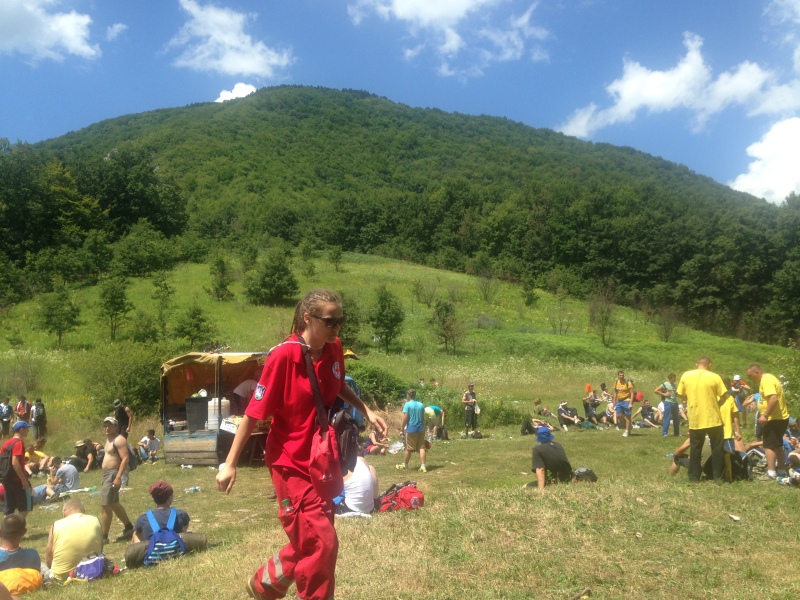

We spent some time with these lovely ladies and their children who happily ate the sweets we carried!
End of the March arrival at the Memorial in Potocari
All the names of those who never came back are engraved on the stone. Many still have not been found yet. Many women did not want to officially say their husbands or sons were dead, they still had some hope left, but after 10 years they had to declare them dead in order to be able to receive a pension.

Noura’s children had been born in 1971, 1973 and 1975 – they would now be my age as I was born 1974 – I kept thinking she would now have grandchildren Maria’s age. They would have been so fortunate to have Noura as their grandma… She would have loved them so much.
We walked around the cemetery. It was so vast we couldn’t fit it even in a panoramic picture.

We felt very sorrowful visiting Refija’s and Noura’s children’s graves.
A group of motorists arrived from Sarajevo in their March of Peace to pay their tributes to the victims.
We pray to almighty God,
May grievance become hope
May revenge become justice
May mothers’ tears become prayers
That Srebrenica
Never happens again
To no one and nowhere
From the Srebrenica prayer, displayed at the memorial site in Bosnian, English and Arabic
Seida and Amra
During the war, Seida worked for Care, an international aid organisation, helping elderly people survive the siege of Sarajevo. They were left alone as their families could not come to help them. During the war, people who worked for International Organisations had “blue badges” to be recognised as humanitarian workers, so Seida was fortunate to have one. It allowed her to get in and out of the siege in organisational vans which were bringing necessity to Sarajevo. It was enormously dangerous as many humanitarian workers were killed doing the same job. Seida says that she felt safe at that time but later realised she had been in many, many dangerous situations particularly being a Muslim passing Serb check points. Thinking and speaking of it even today makes her emotional as many Muslim women ended up in Serbs rape camps.
Here’s a picture of us with Seida!
During the war Amra lived in the safe territory just outside Sarajevo which was under siege from April 1992 until February 1996. Amra lived very close to the frontline from where the Serbs would throw grenades at them. She remembered one day when four 8 to 10 year old children who lived next to her were killed by grenades as they played in the park (it was especially sad for them as two of these children were Amra’s friend’s sons).
At that time, Amra was 22 years old, her sister was 16 and her brother was 9 years old. Her father had to join the Bosnian militia and Amra would help distribute food and medicines supplied by international aid. She also helped at a hospital they had built underground where they had two very good surgeons. Sometimes they didn’t have anything to distribute so they would just visit people who had been abandoned to chat to them and keep them company.
Amra’s dad conditioned the basement for them to live in during the war making some kind of beds on the floor. They had to crawl so as not to be seen from the windows and could never turn the lights on. During the long siege they had no hot water or heating so they had to burn their own furniture or her dad would need to go out at 4.00am to look for wood to heat them up. It must have been very cold in winter considering Sarajevo had been home to the 1984 Winter Olympic Games.
Both her parents were injured once during the war. Amra’s brother would always stay indoors. When war broke out they couldn’t believe what was happening, they felt as if they were living in a movie.
Amra used three times the tunnel that joined both parts of Sarajevo under the airport which was controlled by UN. It was very distressing as there was no ventilation and she would always bump her head because the tunnel was very low. Depending on the number of people in the tunnel and if there were any injured, it could take 1 or 2 hours to cross the tunnel. The snipers were in the mountains and selected their shots as they would reveal their position. When they were drunk, they would start shooting like crazy.
Before the tunnel was built, if someone got caught by UN trying to cross the airport territory, they would turn the lights on so they could get shot by the Serb snipers or they would send them back – this is the reason why the tunnel was built.
Both Seida and Amra are very brave!
Amar took very good care of us during the march. He would normally wait for us at the end of each day’s walk to drive us to the home where we would stay for the night. He also drove us on the last day from Srebrenica to Sarajevo. During the drive we talked about his interesting life. He worked in logistics and had training in Cyprus, Kabul, London and Dublin. During the war he was a soldier and during the last year of the war he worked as interpreter for UN. He was in Karbala in April 2003 when the war started, so he helped build a refugee camp and specialised in water supply to build the tanks and water pipes for the refugees. After living in Aman he moved back to Bosnia and started working for a Canadian company providing family healthcare. He worked sending doctors and nurses from Canada to educate the doctors in Bosnia. During the years 2008 to 2012 he worked in a microcredit program of Women for Women. He is now a freelancer.
Historic background
Historically, Bosnia & Herzegovina has always been disputed between different ethnic groups. Orthodox Christian Serbs and Roman Catholic Croats lived throughout Croatia and Bosnia. Also, the Ottoman Empire ruled for many centuries, leaving a legacy of a Muslim population in Bosnia (‘Bosniaks’); neither Croat nor Serb.
As a consequence, its population has historically been formed by:
- Bosniaks (Bosnian Muslims)
- Bosnian Serbs (Orthodox Christians who have close cultural ties with neighbouring Serbia)
- Bosnian Croats (Roman Catholics who have close cultural ties with neighbouring Croatia).
Yugoslavia was created in 1929 after the unification of Serbia, Croatia, Slovenia, Macedonia, Montenegro, and Bosnia & Herzegovina.
During World War II, extreme nationalist Croats (the Ustaše) were allowed to set up a puppet state by the Nazis. They launched a ferocious campaign of murder, atrocities and ‘ethnic cleansing’ against Serbs, Jews and Gypsies, thousands of them were sent to death camps.
After the war, Communist dictator Josip Broz Tito claimed legitimacy from his role in the defeat of the Nazis and the Ustaše, and suppressed both Croat and Serb nationalism. He set up a complicated federal constitutional structure which carefully balanced the different nationalities in Yugoslavia.
By the 1970s Yugoslavia appeared to the outside world to be peaceful and economically successful. However, the memory of World War II atrocities, and centuries-old ethnic and religious tensions, were still present, despite their public suppression by Tito.
After Tito’s death in 1980, and the decline of communism across Eastern Europe, Yugoslavia’s political settlement was undermined by the resurgence of Serb and Croat nationalism.
Slobodan Milošević, Communist President of Serbia, broke the Titoist taboo and began to use Serbian nationalist sentiment to his own advantage. He engineered the end of autonomous government in the ethnically-mixed Serbian regions of Kosovo and Vojvodina, and ensured a sympathetic leadership was installed in neighbouring Montenegro. Tito’s careful constitutional checks and balances were in tatters, as Serbian leader Milošević now controlled nearly half the country.
The situation inflamed nationalism in Croatia and Slovenia, both suspicious of Serbian nationalism. In 1991 both Slovenia and Croatia declared independence.
Following the collapse of communism, nationalists won the first multi-party elections and formed coalition governments despite having conflicting goals:
- Muslim nationalists wanted a centralised independent Bosnia
- Serb nationalists wanted to stay in Serb-dominated Yugoslavia and join the emerging ‘Greater Serbia’, being created by Milošević
- Croats wanted to join independent Croatian State.
This left multi-ethnic Bosnia & Herzegovina in an impossible position as the three ethnic groups had clashing objectives yet they lived mingled in the same country.
Bosnia & Herzegovina held a referendum on independence in February 1992, which was boycotted by the Bosnian Serbs. After the independence was declared (and recognised by the EU), Serb and federal Yugoslav armies entered Bosnia to secure Serb areas. War broke out and Serbs, under the leadership of Radovan Karadzic, lay siege to the capital city Sarajevo. They occupied 70% of the country killing and persecuting Muslims and Croats to create a Serb Republic.
Bosnia became the victim of the Bosnian Serbs’ determined wish for political domination and they were prepared to achieve this by isolating ethnic groups and, if necessary, exterminating them. The war which followed was a brutal interethnic conflict focused on territorial control.
The Bosnian war lasted 44 months and resulted in the death of around 100,000 people and the displacement of over two million men, women and children.
Sarajevo Siege
Sarajevo, the capital city of Bosnia & Herzegovina was the scene of the longest siege in modern warfare -from April 1992 to February 1996 (1,425 days) the city was encircled by the Serb-controlled army. Civilians endured shelling of their city for nearly four years. A total of 13,952 people were killed during the siege, including 5,434 civilians.
Some of Sarajevo’s inhabitants managed to flee but many stayed – like Amar or Seida’s family who lived very close to the front line while the Serbs where in the mountains surrounding Sarajevo.
Reports indicated an average of approximately 329 shell impacts per day during the course of the siege, with a maximum of 3,777 on 22 July 1993. By September 1993 it was estimated that virtually all the buildings in Sarajevo had suffered some degree of damage and 35,000 were completely destroyed.
The shelling took a heavy toll on residents who suffered mass killings, primarily by mortar attacks. On 1 June 1993, 11 people were killed and 133 were wounded in an attack on a football game.
During the siege they had no water, no electricity and no gas. The had to burn all their wooden furniture and trees to heat themselves during the winters. Sarajevo has a natural source of water so people would gather around the well to get water. A lot of people died getting water as they were targeted by snipers during the walk from their home to the well. On 12 July, twelve people were killed while waiting in line for water.
At the marketplace, the people selling food from humanitarian aid would have protection vests. The most dangerous time to come out was during daylight as they could be attacked by snipers or grenades. Two massacres occurred at the market place:
- the first massacre occurred on 5th February 1994 when a 120 millimeter mortar shell landed in the center of the crowded marketplace killing 68 civilians and injuring 144 civilians
-
the second massacre at the marketplace took place on 28th August 1995 when five mortar shells killed 43 people and wounded 75 others
Apparently the Serbs denied these massacre killings accusing the Bosniaks of putting themselves landmines and fake bodies to catch international attention.
During the siege, 1kg of sugar would cost around 40 euros; 1 litre of oil would cost 40 euros; 2 packs of cigarettes would cost 10 euros (Deutsche Mark was the currency at that time); 1 kg of coffee would cost DM110; 1 can of coke would cost DM10. There was a lot of smuggling going on.
The siege affected all sectors of Sarajevo’s population. UNICEF reported that of the estimated 65,000 to 80,000 children in the city, at least 40% had been directly shot at by snipers; 51% had seen someone killed; 39% had seen one or more family members killed; 19% had witnessed a massacre; 48% had their home occupied by someone else; 73% had their home attacked or shelled; and 89% had lived in underground shelters.
During the weekends, soldiers would came from Serbia to bomb Sarajevo just for fun. They would come from Belgrade spending the weekend in the mountains surrounding Sarajevo shooting and bombing the city to later go back into Belgrade for the start of the week (it was around 4.5 hours drive).
In the Serb territories they had electricity, gas and water and the food prices were as usual. Equally at the UN headquarters they had everything they needed including electricity, meat and vegetables.
According to the Daytona Peace Agreement, the Serbs had to reintegrate into Sarajevo a part of the city that they had occupied during the war. As they evacuated the buildings, they took everything with them, even the graveyards, the doors and windows, everything.
Sarajevo Tunnel
During the siege of Sarajevo, the Bosnian Army built the Sarajevo Tunnel in order to link the city of Sarajevo, which was entirely cut off by Serbian forces, with the Bosnian-held territory on the other side of the Sarajevo Airport (controlled by UN). The tunnel would allow food, war supplies and humanitarian aid to come into de city and people to get out. It was one of the major ways to bypassing the international arms embargo and providing city defenders with weaponry.
The construction of the tunnel began in secret on 1st March 1993. It was dug by hand and was completed on 30th June 1993 when the two tunnels met in the middle. It was 840m long and its height ranged from 0.8m to 1.8m. On average it took 2 hours to travel through the tunnel. Every day between 3,000 and 4,000 Bosniaks and UN soldiers and 30 tons of various goods passed through the tunnel. Throughout the war, between 2 and 3 million Muslims and UN soldiers passed through the tunnel.
After the war, the Sarajevo Tunnel Museum was built on a historic private house whose cellar served as the entrance to Sarajevo Tunnel.
We visited the museum on our last morning just before catching our flight back to Madrid via Munich.
Rape centres
Whilst all parties were to blame for war crimes, Serb nationalism drove the conflict to new and horrendous levels of ethnic brutality. Alongside the large-scale ‘cleansing’ of Bosniak men through siege tactics and killings and the destruction of hundreds of churches, mosques, libraries and museums to wipe out the country’s cultural and historical identity, a strategic rape campaign was also initiated, culminating in the building of 16 ‘rape camps’ usually close to the frontier with Serbia, where women and young girls were often held captive for up to 8 months before being released or killed.
It is estimated that the Serb military forces proceeded to systematically rape, enslave and torture over 44,000 Bosnian Muslim girls and women aged between 18 and 60. Women were also forcibly impregnated and held in the camps until late stages of pregnancy when they were released with no provisions or homes to return to in order to avoid abortion. The children resulting from rape of Bosniak women by Serbs were viewed by Serb forces as ‘clean and purified’.
The victims later sued at the UN war crimes tribunal, which resulted in wartime rapists being put behind bars for the first time in history. So far only 33 people have been convicted for the crimes by local courts and 30 by a UN war crimes tribunal in The Hague. Rape victims were only recognised a couple of years ago as war victims. They now receive a pension and help from government.
The Srebrenica Massacre
On 16th April 1993, the United Nations Security Council declared that Srebrenica was a ‘safe area’ and called for the area to be free from armed attacks.
During the weeks leading up to 6th July 1995, tens of thousands of non-Serbs had taken refuge in Srebrenica from Serbian attacks in the north-east of Bosnia. The refugees were under the protection of Dutch Infantry forces, and fresh food and water were in short supply.
On 6th July 1995 Bosnian Serb troops and paramilitaries led by Ratko Mladić descended on the town of Srebrenica and began shelling it.
As shelling intensified, more refugees from camps in the south fled to the town. Approximately 4,000 refugees were in the centre by 10th July and chaos spread as large crowds of refugees gathered around the Dutch base at Potocari.
The Dutch commander called for NATO air support to stop the shelling, however, assistance was delayed by the completion of the incorrect paperwork and NATO planes needing to refuel.
By the afternoon of 11th July, Serb Commander Ratko Mladić arrived in the city. At that time more than 20,000 refugees had arrived at the main Dutch base at Potocari. Serbs threatened to kill Dutch hostages and to shell refugees after Dutch F-16 fighters had bombed Serb positions.
Dutch UN Lieutenant Colonel Karremans arranged a meeting with Ratko Mladic to try to negotiate the release of thousands of civilians and ask for protection for the Dutch peacekeepers. Ratko Mladic delivered an ultimatum that Muslims must hand over their weapons.
On the evening of 12th July 1995, approximately 15,000 men and boys over 12 years old who were being held in trucks and warehouses in Srebrenica managed to escape, but were shelled as they attempted to flee for safety across the mountains. They formed a column and began to walk towards Tuzla, safe territory. Serb forces created numerous ambushes and attacks on the column of Bosnian Muslims throughout their journey. Four days later, the column of men arrived in Tuzla, exhausted. Many were injured. No more than 4,000 of the original column survived the journey, and it is thought that 2,000 refugees remained in hiding in various parts of the journey after the main column reached Tuzla.
On 13th July Dutch peacekeepers handed over some 5,000 Muslims sheltering at the Dutch base in exchange for the release of 14 Dutch peacekeepers held by Bosnian Serbs. After the Dutch left Srebrenica, Serb troops managed to get hold of some of UN uniforms and wore them to trick Bosniaks who would approach them thinking they were UN peacekeepers.
On 14th July reports of massacres started to emerge.
Around 8,000 Muslim men, and boys over 12 years old, were killed in Srebrenica. Up to 3,000, many in the act of trying to escape, were shot or decapitated in the fields. 1,500 were locked in a warehouse and sprayed with machine gun fire and grenades. Others were murdered in their thousands with machine guns and grenades on farms, football fields and school playgrounds. Thousands of bodies were buried in mass graves. Some of the bodies have been recovered and reburied, but identification has proved extremely difficult.
The massacre at Srebrenica was one of the most horrific events of the war in the former Balkan States. It remains the single largest mass murder in Europe since World War II.
BBC news video Srebrenica falls to Bosnian Serbs
BBC news video of women and children arriving at Tuzla with no husbands or sons
BBC news video of Srebrenica and first survivors arriving at safe territory
The end of the war
After the Srebrenica genocide and the second marketplace massacre in Sarajevo in August 1995, NATO launched a bombing campaign in Bosnia & Herzegovina against Bosnian Serb troops lasting from 30th August until 20th September 1995.
In November, Bosnian Muslim President Alija Izetbegovic, Croatian President Franjo Tudjman and Serbian President Slobodan Milosevic agreed to a US-brokered peace deal in Dayton, Ohio. The peace agreement was signed in December 1995 effectively ending the Bosnian war, the worst conflict in Europe since World War II.
Bosnia and Herzegovina was confirmed as an independent and unified state, made up of two federal entities:
- the (Bosniak-Croat) Federation of Bosnia-Herzegovina – which would keep 51% of the territory
- and the (Serb) Republika Srpska – which would keep 49% of the territory (during the war they had controlled 46% of Bosnia & Herzegovina)
The Peace March actually takes place in Srpska Republic (controlled by Serbs), where we spent our three days. It is part of Bosnia & Herzegovina but it is independent as we could see during the Peace March that they have their own policemen (dressed in blue whereas the Federation policemen wear grey uniforms).
Srebrenica also lies within the borders of the Republika Srpska. Its prewar Bosniak population of nearly 30,000 has plummeted to just a few thousand, despite guarantees that survivors should be able to return.
The war lasted 44 months. On average a hundred people died every single day for more than three and a half years in a country the size of Scotland. Out of the Serbs war casualties, 80% were soldiers whereas 70% of the Bosniak casualties were civilians.
Responsibility for crimes against humanity – Forgiveness
We found it truly shocking how even though this war officially ended nearly 20 years ago, the country is still divided and to this day the Bosniaks are still waiting to identify the bodies of their loved ones so that they can at last be respectfully laid to rest, but it is taking years and years because Serbs will not cooperate finding mass graves.
Many Serbs are proud of their acts during the war and do not recognise the genocide. On the contrary. On the 11th of July the ceremony takes place when bodies found in mass graves and identified through ADN tests are buried at the Srebrenica-Potocari Memorial, in Republika Srpsk. Thousands of people come to Srebrenica for the ceremony. However, it is shameful that most of them go back home that same day as the following day, 12th of July, hundreds of Serbs celebrate the fall of Srebrenica and the triumph of the Serb army in the same streets.
It must be very difficult for war victims like Elvir, Noura and Rafidja to live within the Republika Srpsk territory as the war wounds are still open. Many of them know who was the sniper in their local area or who raped a family member but there have been no trials or signs of true repentance.
In 2007, the International Court of Justice, the United Nation’s highest judicial body, ruled that the Srebrenica massacre was an act of genocide, confirming the judgment of the International Criminal Tribunal for the former Yugoslavia.
However, Serbian media and politicians are very sceptic about the events at Srebrenica.
In March 2005, Miloš Milovanović, a former commander of the Serb paramilitary unit Serbian Guard who represents the Serbian Democratic Party in the Srebrenica Municipal Assembly said that “the massacre is a lie; it is propaganda to paint a bad picture of the Serbian people. The Muslims are lying; they are manipulating the numbers; they are exaggerating what happened.”
Tomislav Nikolić, President of Serbia, stated on 2nd June 2012 that “there was no genocide in Srebrenica. In Srebrenica, grave war crimes were committed by some Serbs who should be found, prosecuted and punished. […] It is very difficult to indict someone and prove before a court that an event qualifies as genocide.”
The International Criminal Tribunal for the Former Yugoslavia still has 4 cases on trial, including Ratko Mladić who is accused of participating in a joint criminal enterprise to permanently remove Bosnian Muslims and Bosnian Croats from the parts of Bosnia claimed as Bosnian Serb territory and of participating in a joint criminal enterprise to eliminate the Bosnian Muslims in Srebrenica by killing the men and boys of Srebrenica and forcibly removing the women, young children and some elderly men.
Bosnia & Herzegovina today
Half of Bosnia & Herzegovina’s population was displaced by the conflict, and still today around one million (of the prewar population of 4.5 million) live abroad. The Bosnian diaspora is concentrated in the USA, Germany, Croatia, Serbia, Austria, Slovenia, Sweden, Canada and Australia. Remittances from these former refugees now make up a significant portion of Bosnia’s economy.
Bosnia’s population before the war was approximately 4.5 million whereas today it is estimated at 3.87 million of which 48% are Bosniaks, 37.1% are Serbs, 14.3% are Croats and 0.6% other. In terms of religion, 40% of the population is Muslim, 31% Orthodox, 15% Roman Catholic and 14% other. The Constitution provides for freedom of religion which is increasing among younger people. When we visited Sarajevo before flying back to Madrid we could see that within 300 metres we could find a synagogue, a mosque, a cathedral and an orthodox church. Due to its long and rich history of religious and cultural variety, Sarajevo is often called the ‘Jerusalem of Europe’.
The Bosnian Muslims (Bosniaks) descend from Bosnjani who accepted Islam in the 15th century when Islam was brought to this region by the Ottomans. For some Bosniaks, religion often serves as a community identifier and their religious practice will be limited to occasional visits to the mosque or significant rites such as birth, marriage and death. While there are significant Bosniaks who practice their faith to varying degrees, for others, this identity tends to be secular and is based primarily on ancestral traditions and ethnic loyalty.
During the Peace March we learned that some Serbs still call Bosniaks ‘Turks’ and they blame them for what their ancestors did 500 years ago.
Bosnia continues to function uneasily under the Dayton Peace Agreement – with a complicated constitutional structure overseen by the international community, in the form of the High Representative, who can overrule local politicians when he decides to. There is little trust between Bosnian Serbs and Bosnian Muslims and Croats. Former High Representative Paddy Ashdown has said ‘All three ethnic groups are cohabiting peacefully, if not yet cooperating enthusiastically, and the economy is growing, albeit from a very low base.’
The representation of the government of Bosnia & Herzegovina is quite complicated. There are three major groups which represent the three major ethnic groups and have a guaranteed share of power (33% of the political power). Three members of the Presidency (one Bosniak, one Croat, one Serb) are elected by popular vote for a four-year term, they are elected directly by the people with Federation voters voting for the Bosniak and the Croat, and the Republika Srpska voters for the Serb.
The Chair of the Presidency of Bosnia & Herzegovina rotates among the three members (Bosniak, Serb, Croat), each elected as the Chair for an eight-month term within their four-year term as a member.
Government spending at roughly 50% of GDP remains very high because of redundant government offices at the state, entity and municipal level. It is very expensive to maintain three ethnical political groups within the Government structure and unfortunately, the country suffers a lot of political corruption which aggravates the situation. However it would be very difficult for a multi-ethnic party who represented all three cultures to succeed and become popular and if it ever did, the constitution would have to be changed.
Whilst political reconciliation has been challenging, the Bosnian economy has made progress and tourism is growing rapidly. The economy relies heavily on the export of metals as well as remittances and foreign aid. One of the country’s main economic challenges is to reduce spending on public sector wages and social benefits.
The country is rich in agriculture flower beds , fruit trees, corn, honey, and beans to export. During the communist period, people preferred to work in factories because working the land is a hard job. Farmers were not allowed to sell their products on their own – they had to sell them through an agricultural association established by the Government which would pay farmers below the sale price of their products. All the business areas were state property. Today people have realised that working the land is a good source of income. There are still some big factories remaining which ecologically are not very good.
We arrived safely in Madrid with lots of unanswered questions
- how can war exist? what its purpose supposed to be?
- was this war worth it? So many dead people… lives of the survivors destroyed… how did we allow this to happen?
- will Humans ever acknowledge that war is no solution to problems but on the contrary, it creates more problems?
- the embarrassing role of UN in Srebrenica
- how is it possible that 19 years later so many bodies are still missing? Does the International Community not care?
- how do these families, especially mothers, find the strength to live not knowing the fate of their son and not being able to mourn him at their grave?
- how could this brutality have happened on European soil, so close to us?
- how many people today are going through exactly the same suffering as the Bosniaks during the war?
- how easily can a human being be tricked into going to war to kill its neighbours?
- were Serbs soldiers on drugs? How could they have committed all those crimes and sleep peacefully with no remorse?
- is there anything we can do besides remembering Srebrenica and trying to help women like Noura and Refija?
- why do some of us live wonderful lives and others have to go through so much suffering?
- was Hunger Games (the series of books and films) inspired by stories like Elvir’s?
‘Bad people who lusted for power killed these good people simply because of who they were. But Srebrenica was the beginning of the end of genocide in Europe. […] We remember this terrible crime because we dare not forget, because we must pay tribute to the innocent lives, many of them children, snuffed out in what must be called genocidal madness. […] I hope the very mention of the name “Srebrenica” will remind every child in the world that pride in our own religious and ethnic heritage does not require or permit us to dehumanize or kill those who are different. I hope and pray that Srebrenica will be for all the world a sober reminder of our common humanity. […] May God bless the men and boys of Srebrenica and this sacred land their remains grace.’ Bill Clinton
Women for Women International
Women for Women International was founded in 1993 by Zainab Salbi and Amjad Atallah to offer financial and emotional support to women displaced by the Bosnian War.
Since 1993, WfWI has helped nearly 420,000 marginalised women in 8 countries affected by war and conflict working directly with women offering support, tools, and access to life-changing skills to move from crisis and poverty to stability and economic self-sufficiency.
Zainab Salbi is an Iraqi-American humanitarian, entrepreneur, author, and media commentator who has dedicated herself to women’s rights and freedom. At the age of 23, she founded Women for Women International—a grassroots humanitarian and development organization dedicated to serving women survivors of war.
WfWI in Bosnia & Herzegovina (Žene za Žene) has operated since 1993 and served nearly 62,000 women. Its economic empowerment programme increases opportunities for Žene za Žene graduates and women’s associations to contribute to their families and their communities. Its civic engagement programme increases the participation of graduates and women’s associations in local government and in grassroots, issue-based advocacy organisations.
Seida Saric serves as the Country Director for Women for Women International – Bosnia & Herzegovina, where she manages programmes that have served more than 61,000 women since 1993. She was the first Country Director for any Women for Women International country programme, joining the organisation in 1998.
Under Seida’s leadership, Women for Women International developed its yearlong programme to provide women vocational and business skills training, rights awareness, health education, and emotional and financial support. She also pioneered a successful microcredit program that provided loans to nearly 30,000 women totaling more than USD $55 million. In places like Srebrenica, she has worked to bridge religious and ethnic divides between communities and to rebuild trust through joint programming for women.
Seida is a frequent guest at seminars and conferences around the world advocating for gender equality. Her portfolio of experience includes work in Care International and Save the Children and her educational background spans from engineering to business.
If you would like to learn more about the March for Peace, please visit:
http://www.womenforwomen.org.uk/help-women/bosnia-peace-march.php
If you would like to learn more about the Srebrenica genocide, please visit:
http://en.wikipedia.org/wiki/Srebrenica_massacre
http://en.wikipedia.org/wiki/Srebrenica_Genocide_Memorial
http://hmd.org.uk/genocides/bosnia
https://remembersrebrenicagenocide.wordpress.com/srebrenica-genocide-timeline/
BBC news reports about the massacre: http://www.bbc.co.uk/search?q=Srebrenica%20massacre
http://news.bbc.co.uk/1/hi/world/europe/8326089.stm (arrival to safe territory of the first survivors)
Meetings on the 11th July 1995 between Dutch UN Lieutenant Colonel Karremans and General Mladic negotiating the release of thousands of civilians:
If you would like to learn more about Bosnia & Herzegovina, please visit:
Bosnian Institute – UK charity providing education and information on the history and culture of Bosnia-Herzegovina, with a special concern for the past and present development of its social, economic, governmental, legal and cultural conditions, organizations and institutions
International Criminal Tribunal for former Yugoslavia
Presidency of Bosnia and Herzegovina
BBC correspondent Allan Little wrote a lot about Srebrenica and the War in the Balkans. Reading some of his reports I would like to share this extract with you: ‘I asked the man how old he was. He said he was 80. May I ask you, I said, are you a Muslim or a Croat? And the answer he gave me still shames me as it echoes down the decades in my head. I am, he said, a musician.’
http://news.bbc.co.uk/1/hi/world/europe/675945.stm
http://www.youtube.com/watch?v=7XcPnss5uKU#
http://www.youtube.com/watch?v=MtIzLvW_3XE#
http://www.youtube.com/watch?v=XBWDXQTJVuM#
http://www.youtube.com/watch?v=-tQCQzdfnKc#
http://www.youtube.com/watch?v=od7CmTtaZIo
http://www.youtube.com/watch?v=TNKbab5bFeQ#!
Scorpions massacre video released in 2005 – six Muslim men and boys were forced to lie down with their hands tied before being shot in the back by their captors. Two of the victims were 17, while the others were in their 20s and 30s. The video was deemed particularly shocking in Serbia, where many still believed the Milosević-era propaganda that the massacre in 1995 never happened. In Bosnia, it led to the identification of at least one victim by his family, who saw the video on television
Bono and Pavarotti join voices to sing Miss Sarajevo
Below you can click to see the Briefing Pack we received before traveling to complete the March of Peace. It includes interesting information about Bosnia and Herzegovina (its history, the conflict, its current political situation, book recommendations, info about Women for Women International in Bosnia Herzegovina…):
Briefing Pack Bosnia Trip 2014
